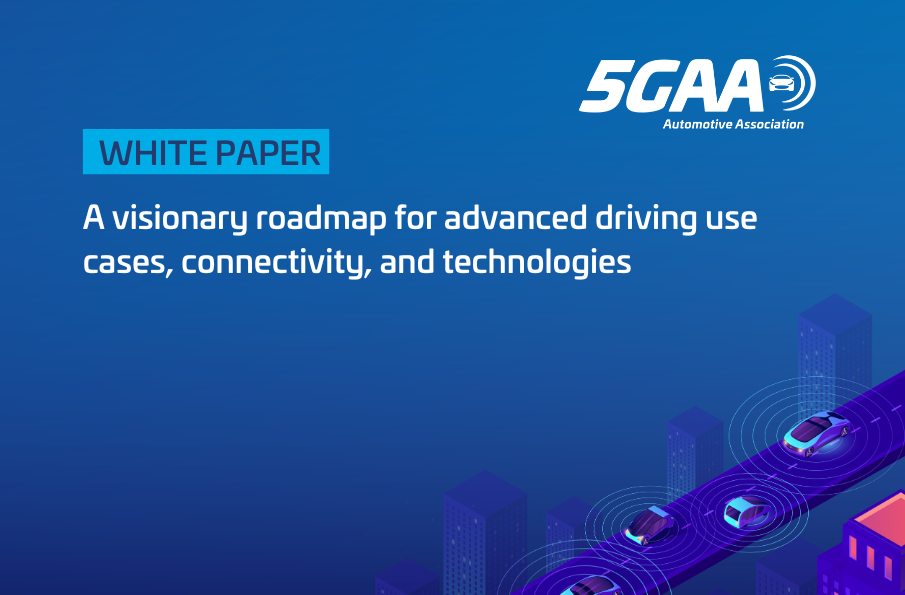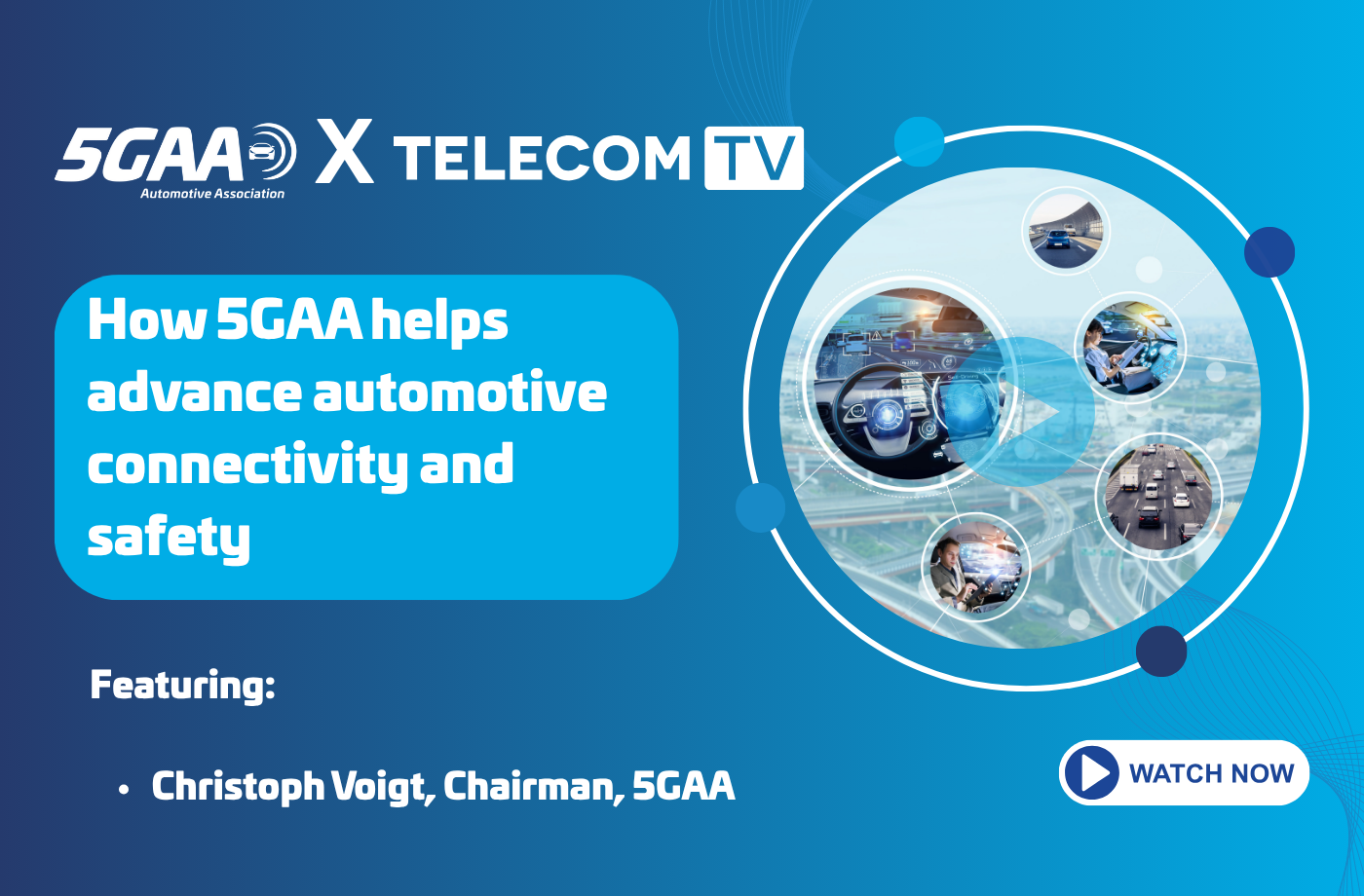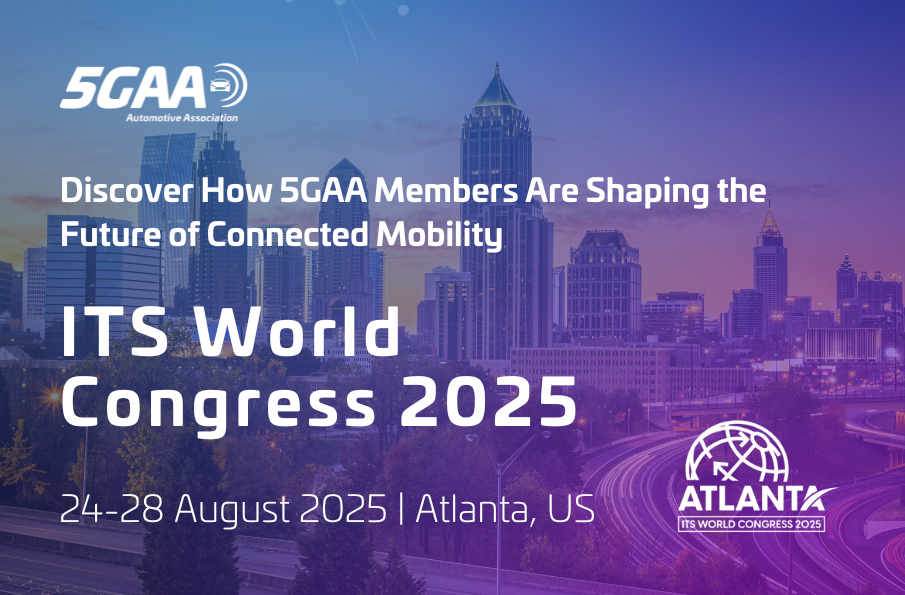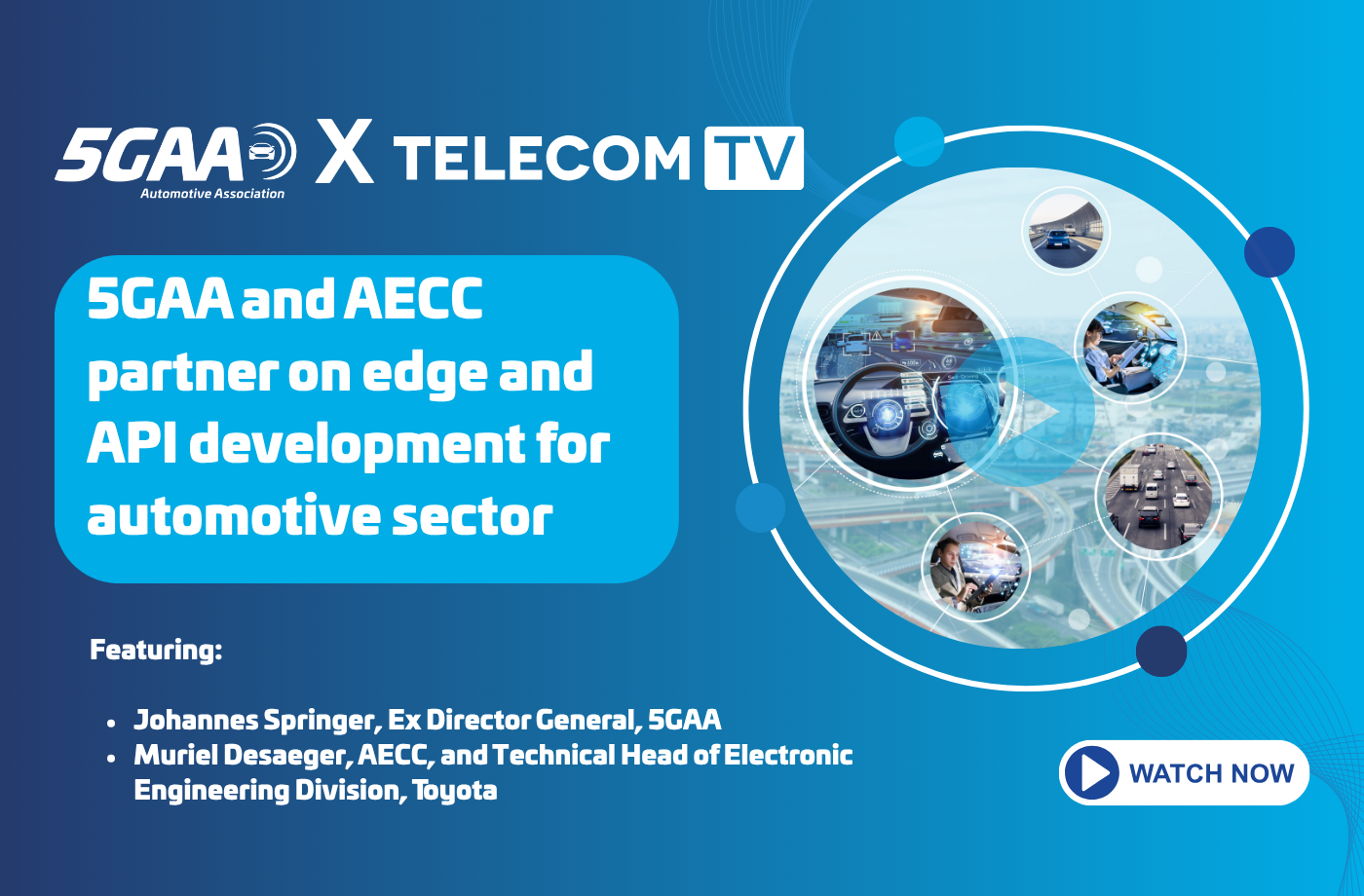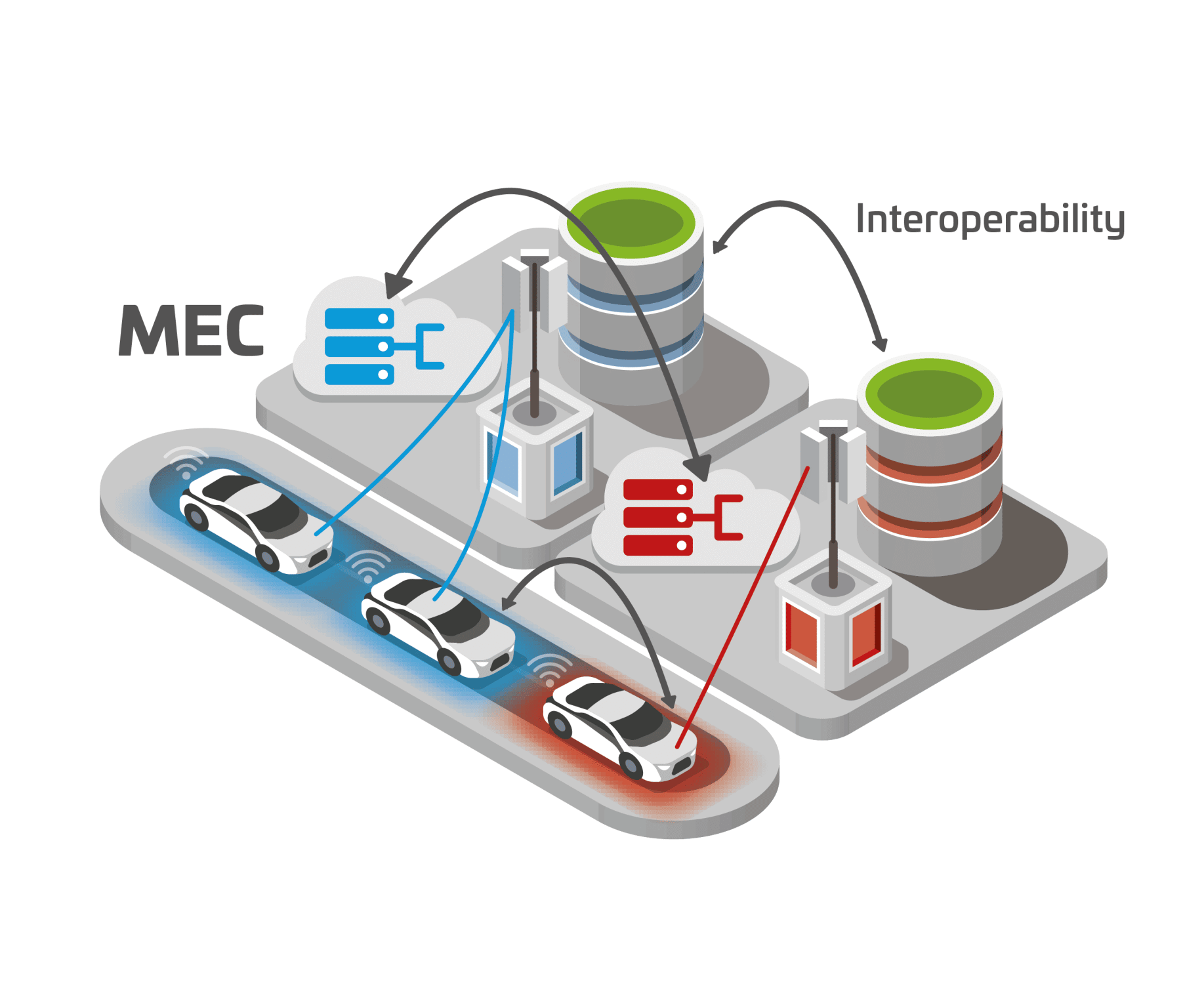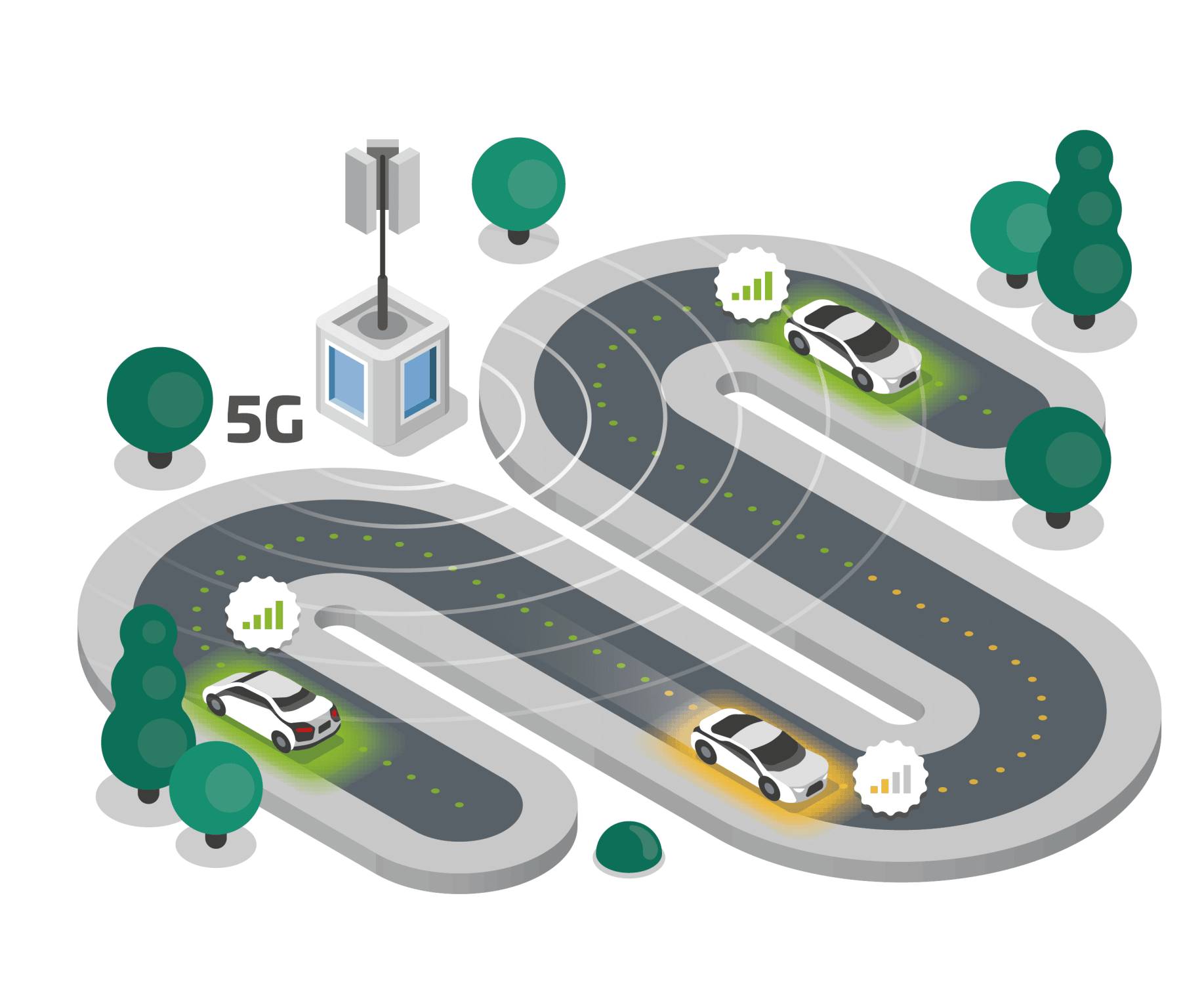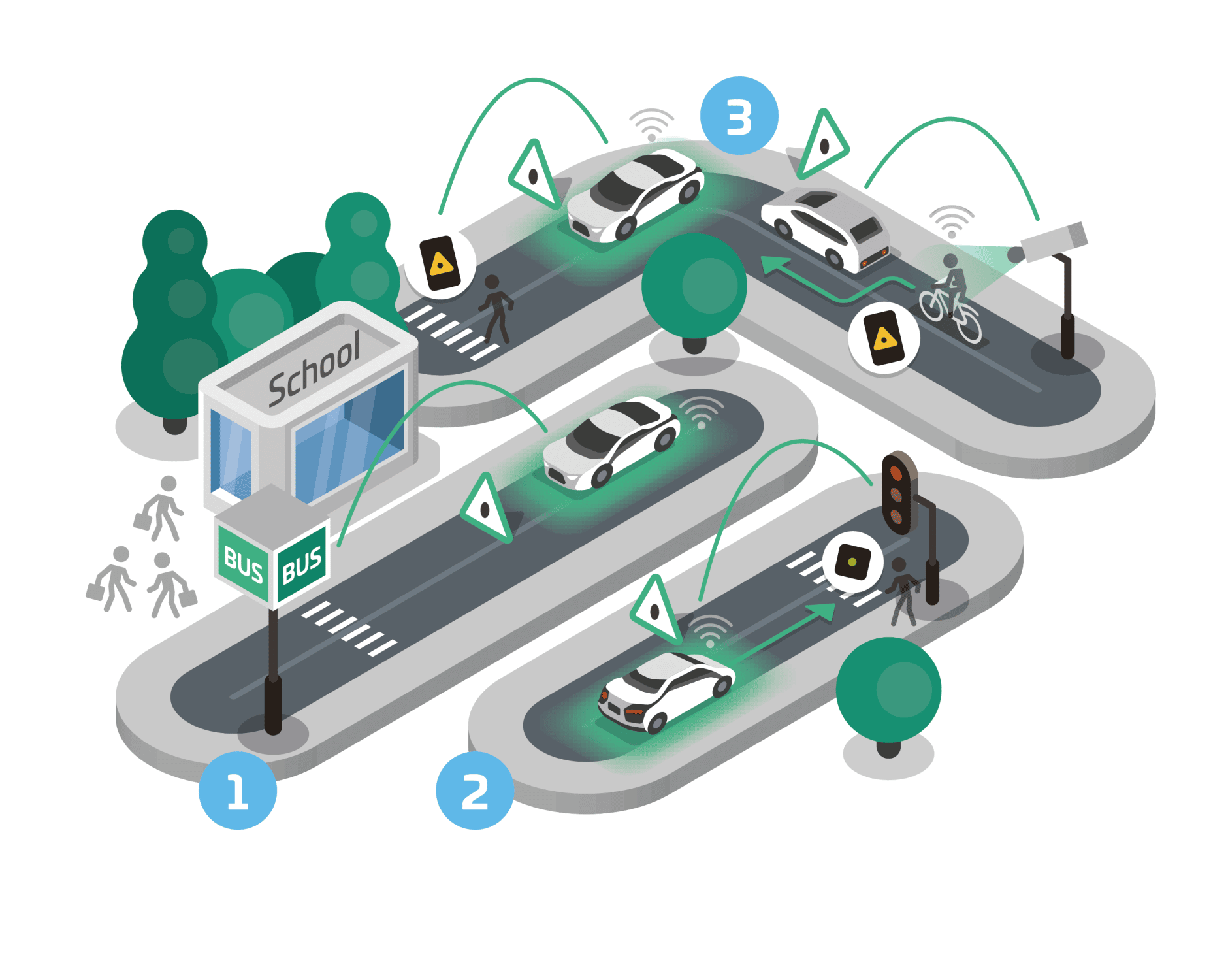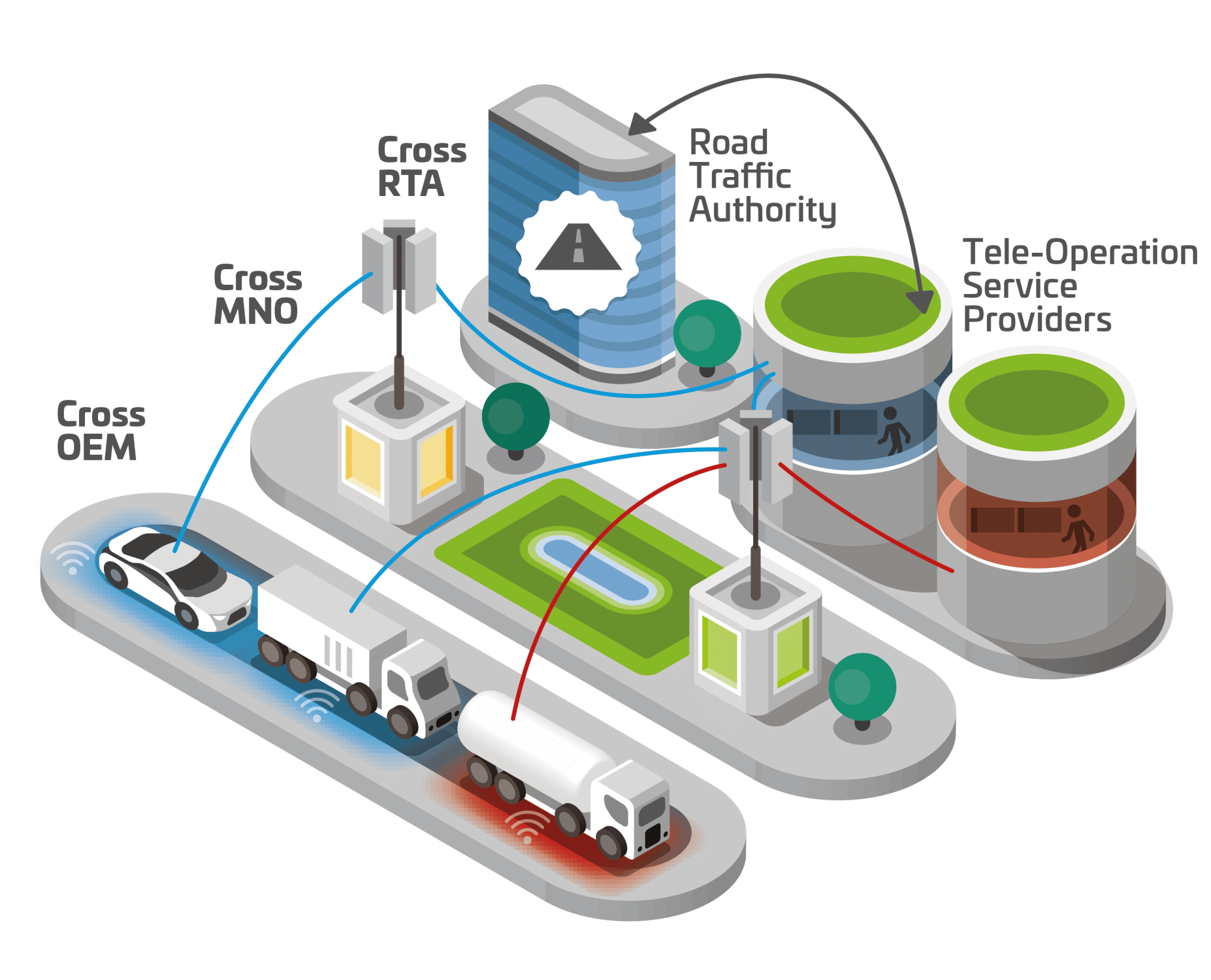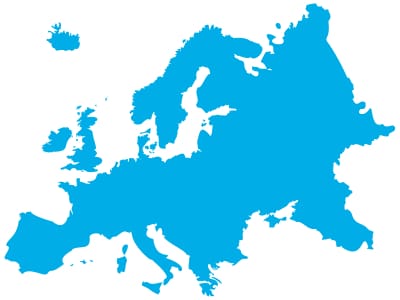Home
The 5G Automotive Association (5GAA) is a global, cross-industry organisation of companies from the automotive, technology, and telecommunications industries (ICT), working together to develop end-to-end solutions for future mobility and transportation services.
5GAA at a glance
+115 Members Community
52 Completed Work Items Work Items
7 Working Groups Items
1 Objective Connected mobility
What’s new
All news
5GAA celebrates 5 years
Celebrating 5 years of digital transformations
and innovative mobility solutions
meeting today’s challenges.
5GAA leverages today’s and tomorrow’s mobility solutions
According to the World Health Organization (WHO), roughly 1.25 million road traffic fatalities worldwide in 2013, with another 20–50 million injured or disabled through traffic accidents. Vehicles sharing information make transportation safer, greener, and more enjoyable are at our doorstep. The technologies associated with this concept are collectively known as Cooperative Intelligent Transportation Systems (C-ITS). The impact on road safety alone is sufficiently significant to make C-ITS a priority.

5GAA contribution focuses on 5 pillars
Latest publications
Terms of Use
Ownership of Site; Agreement to Terms of Use
These Terms and Conditions of Use (the “Terms of Use”) apply to the 5GAA web site located at www.5gaa.org, and all associated sites linked to www.5gaa.org by 5GAA, its subsidiaries and affiliates, including 5GAA sites around the world (collectively, the “Site”). The Site is the property of 5GAA – 5G Automotive Association e.V. (5GAA) and its licensors.
BY USING THE SITE, YOU AGREE TO THESE TERMS OF USE; IF YOU DO NOT AGREE, DO NOT USE THE SITE.
Content
All text, graphics, user interfaces, visual interfaces, photographs, trademarks, logos, sounds, music, artwork and computer code (collectively, “Content”), including but not limited to the design, structure, selection, coordination, expression and arrangement of such Content, contained on the Site is owned, controlled or licensed by or to 5GAA, and is protected by trade dress, copyright, patent and trademark laws, and various other intellectual property rights and unfair competition laws.
Except as expressly provided in these Terms of Use, no part of the Site and no Content may be copied, reproduced, republished, uploaded, posted, publicly displayed, encoded, translated, transmitted or distributed in any way (including “mirroring”) to any other computer, server, Web site or other medium for publication or distribution or for any commercial enterprise, without 5GAA’s express prior written consent.
You may use information on 5GAA products and services (such as data sheets, knowledge base articles, and similar materials) purposely made available by 5GAA for downloading from the Site, provided that you (1) not remove any proprietary notice language in all copies of such documents, (2) use such information only for your personal, non-commercial informational purpose and do not copy or post such information on any networked computer or broadcast it in any media, (3) make no modifications to any such information, and (4) not make any additional representations or warranties relating to such documents.
Your Use of the Site
You may not use any “deep-link”, “page-scrape”, “robot”, “spider” or other automatic device, program, algorithm or methodology, or any similar or equivalent manual process, to access, acquire, copy or monitor any portion of the Site or any Content, or in any way reproduce or circumvent the navigational structure or presentation of the Site or any Content, to obtain or attempt to obtain any materials, documents or information through any means not purposely made available through the Site or allowed by law. 5GAA reserves the right to bar any such activity.
You may not attempt to gain unauthorized access to any portion or feature of the Site, or any other systems or networks connected to the Site or to any 5GAA server, or to any of the services offered on or through the Site, by hacking, password “mining” or any other illegitimate means.
You may not probe, scan or test the vulnerability of the Site or any network connected to the Site, nor breach the security or authentication measures on the Site or any network connected to the Site. You may not reverse look-up, trace or seek to trace any information on any other user of or visitor to the Site, or any other customer of 5GAA, including any 5GAA account not owned by you, to its source, or exploit the Site or any service or information made available or offered by or through the Site, in any way where the purpose is to reveal any information, including but not limited to personal identification or information, other than your own information, as provided for by the Site.
You agree that you will not take any action that imposes an unreasonable or disproportionately large load on the infrastructure of the Site or 5GAA’s systems or networks, or any systems or networks connected to the Site or to 5GAA.
You agree not to use any device, software or routine to interfere or attempt to interfere with the proper working of the Site or any transaction being conducted on the Site, or with any other person’s use of the Site.
You may not forge headers or otherwise manipulate identifiers in order to disguise the origin of any message or transmittal you send to 5GAA on or through the Site or any service offered on or through the Site. You may not pretend that you are, or that you represent, someone else, or impersonate any other individual or entity.
You may not use the Site or any Content for any purpose that is unlawful or prohibited by these Terms of Use, or to solicit the performance of any illegal activity or other activity which infringes the rights of 5GAA or others.
Accounts, Passwords and Security
Certain features or services offered on or through the Site may require you to open an account (including user ID and password). You are entirely responsible for maintaining the confidentiality of the information you hold for your account, including your password, and for any and all activity that occurs under your account as a result of your failing to keep this information secure and confidential. You agree to notify 5GAA immediately of any unauthorized use of your account or password, or any other breach of security. You may be held liable for losses incurred by 5GAA or any other user of or visitor to the Site due to someone else using your user ID, password or account as a result of your failing to keep your account information secure and confidential.
You may not use anyone else’s user ID, password or account at any time without the express permission and consent of the holder of that user ID, password or account. 5GAA cannot and will not be liable for any loss or damage arising from your failure to comply with these obligations.
Privacy / Data Protection
The information/personal data that you provide about yourself to 5GAA will be used in accordance with 5GAA Privacy Policy. Additionally, by using the Site, you acknowledge and agree that Internet transmissions are never completely private or secure. You understand that any message or information you send to the Site may be read or intercepted by others, even if there is a special notice that a particular transmission (for example, credit card information) is encrypted.
By visiting 5GAA’s website with cookies enabled, and accepting cookies via our cookie consent tool you agree to the use of cookies as explained in the Cookie policy. For more information on how we use cookies and to manage your preferences see Cookie policy.
Links to Other Sites and to the 5GAA Site
This Site may contain links to other independent third-party Web sites (“Linked Sites”). These Linked Sites are provided solely as a convenience to our visitors. Such Linked Sites are not under 5GAA’s control, and 5GAA is not responsible for and does not endorse the content of such Linked Sites, including any information or materials contained on such Linked Sites. You will need to make your own independent judgment regarding your interaction with these Linked Sites.
Disclaimers
5GAA DOES NOT PROMISE THAT THE SITE OR ANY CONTENT, SERVICE OR FEATURE OF THE SITE WILL BE ERROR-FREE OR UNINTERRUPTED, OR THAT ANY DEFECTS WILL BE CORRECTED, OR THAT YOUR USE OF THE SITE WILL PROVIDE SPECIFIC RESULTS. THE SITE AND ITS CONTENT ARE DELIVERED ON AN “AS-IS” AND “AS-AVAILABLE” BASIS. ALL INFORMATION PROVIDED ON THE SITE IS SUBJECT TO CHANGE WITHOUT NOTICE. 5GAA CANNOT ENSURE THAT ANY FILES OR OTHER DATA YOU DOWNLOAD FROM THE SITE WILL BE FREE OF VIRUSES OR CONTAMINATION OR DESTRUCTIVE FEATURES. 5GAA DISCLAIMS ALL WARRANTIES, EXPRESS OR IMPLIED, INCLUDING ANY WARRANTIES OF ACCURACY, NON-INFRINGEMENT, MERCHANTABILITY AND FITNESS FOR A PARTICULAR PURPOSE. 5GAA DISCLAIMS ANY AND ALL LIABILITY FOR THE ACTS, OMISSIONS AND CONDUCT OF ANY THIRD PARTIES IN CONNECTION WITH OR RELATED TO YOUR USE OF THE SITE. YOU ASSUME TOTAL RESPONSIBILITY FOR YOUR USE OF THE SITE AND ANY LINKED SITES. YOUR SOLE REMEDY AGAINST 5GAA FOR DISSATISFACTION WITH THE SITE OR ANY CONTENT IS TO STOP USING THE SITE OR ANY SUCH CONTENT. THIS LIMITATION OF RELIEF IS A PART OF THE BARGAIN BETWEEN THE PARTIES.
The above disclaimer applies to any damages, liability or injuries caused by any failure of performance, error, omission, interruption, deletion, defect, delay in operation or transmission, computer virus, communication line failure, theft or destruction of or unauthorized access to, alteration of, or use, whether for breach of contract, tort, negligence or any other cause of action.
5GAA reserves the right to do any of the following, at any time, without notice: (1) to modify, suspend or terminate operation of or access to the Site, or any portion of the Site, for any reason; (2) to modify or change the Site, or any portion of the Site, and any applicable policies or terms; and (3) to interrupt the operation of the Site, or any portion of the Site, as necessary to perform routine or non-routine maintenance, error correction, or other changes.
Limitation of Liability
Except where prohibited by law, in no event will 5GAA be liable to you for any indirect, consequential, exemplary, incidental or punitive damages, including lost profits, even if 5GAA has been advised of the possibility of such damages.
Indemnity
You agree to indemnify and hold 5GAA, its officers, directors, shareholders, predecessors, successors in interest, employees, agents, subsidiaries and affiliates, suppliers and licensors harmless from any demands, loss, liability, claims or expenses (including attorneys’ fees), made against 5GAA by any third party due to or arising out of or in connection with your use of the Site.
Violation of These Terms of Use
5GAA may share information 5GAA has collected about you in certain situations to comply with court orders, laws or legal processes. For further details, see our 5GAA Privacy Policy.
You agree that 5GAA may, in its sole discretion and without prior notice, terminate your access to the Site and/or block your future access to the Site if we determine that you have violated these Terms of Use or other agreements or guidelines which may be associated with your use of the Site. You also agree that any violation by you of these Terms of Use will constitute an unlawful and unfair business practice, and will cause irreparable harm to 5GAA, for which monetary damages would be inadequate, and you consent to 5GAA obtaining any injunctive or equitable relief that 5GAA deems necessary or appropriate in such circumstances. These remedies are in addition to any other remedies 5GAA may have at law.
You agree that 5GAA may, in its sole discretion and without prior notice, terminate your access to the Site, for cause, which includes (but is not limited to) (1) requests by law enforcement or other government agencies, (2) a request by you (self-initiated account deletions), (3) discontinuance or material modification of the Site or any service offered on or through the Site, or (4) unexpected technical issues or problems.
If 5GAA does take any legal action against you as a result of your violation of these Terms of Use, 5GAA will be entitled to recover from you, and you agree to pay, all reasonable attorneys’ fees and costs of such action, in addition to any other relief granted to 5GAA. You agree that 5GAA will not be liable to you or to any third party for termination of your access to the Site as a result of any violation of these Terms of Use.
Governing Law and Jurisdiction
Unless otherwise specified, the Content and services described on this Site are available only to EU residents. The information on this Site is not directed at anyone other than EU residents.
These Terms of Use shall be governed by, and construed in accordance with, German law. The parties irrevocably agree that the courts of Germany shall (subject to the paragraph below) have exclusive jurisdiction to settle any dispute which may arise out of, under, or in connection with these Terms of Use or the legal relationship established by them, and for those purposes irrevocably submit all disputes to the jurisdiction of German courts.
For the exclusive benefit of 5GAA, 5GAA shall also retain the right to bring proceedings as to the substance of the matter in the courts of the country of your residence or, where these Terms of Use are entered into in the course of your trade or profession, the country of your principal place of business.
Miscellaneous
5GAA may, in its discretion, change these Terms of Use (including those that relate to your use of the Site). Whenever the Terms of Use are changed, 5GAA will notify you by e-mail or by publishing the revised terms on the website. If you use the Site after 5GAA has published or notified you of the changes, you are agreeing to be bound by those changes. If you do not agree to be bound by those changes, you should not use the Site any further after they are published.
No delay or omission on the part of either party in requiring performance by the other party of its obligations will operate as a waiver of any right.
If any provision of these Terms of Use is invalid or unenforceable, such will not render all the Terms of Use unenforceable or invalid. Rather, the Terms of Use will then be read and construed as if the invalid or unenforceable provision(s) are not contained therein. Any cause of action of yours with respect to these Terms of Use must be filed in a court of competent jurisdiction in Germany, within one year after the cause of action has arisen, or such cause will be barred, invalid and void.
5GAA provides access to 5GAA international data and, therefore, may contain references or cross references to 5GAA products, programs and services that are not announced in your country. Such reference does not imply that 5GAA in your country intends to announce such products, programs or services.
Notices to 5GAA must be given in writing, by letter, and sent to Neumarkter Strasse 21, 81673 Munich, Germany.
Save as expressly referred to herein, any representation, warranty, term or condition not expressly set out in these Terms of Use shall not apply.
Headings in these Terms of Use are for convenience only and have no legal meaning or effect, nor shall they be taken into account in interpreting these Terms of Use.
Privacy policy
The 5GAA – 5G Automotive Association e.V. (5GAA) places great importance on the protection of your personal data and is committed to comply with all applicable data protection laws and regulations.
The following Privacy Notice will provide you with information about the personal data we collect, process and use when you visit 5GAA’s website, become a member of the association, otherwise use our services or when we interact or communicate with you in any other way. Please note that if you use services provided by third parties, only the Privacy Notice of these third parties shall apply to the personal data processed via these services.
1. Who is responsible for the processing of your personal data?
The responsible data controller, that means the entity deciding why and how to process your personal data, is:
5GAA – 5G Automotive Association e.V.
Neumarkter Str. 21
81673 Munich (Germany)
Tel.: + 49 89 54 90 96 80
Fax: + 49 89 54 90 96 85
secretariat@5gaa.org
5GAA is a global, cross-industry organization of companies from the automotive, technology, and telecommunications industries (ICT), working together to develop end-to-end solutions for future mobility and transportation services.
2. What personal data do we collect?
We collect information from you when you use our website, complete our “Contact us” form, apply to join the association or to cooperate with us in any other way, are a member of the association, join or participate in our working groups, register for an event or otherwise interact with us. We may also receive information on you from our member companies and institutions that you are associated with (for example as an employee).
The personal data we collect might include your title, first name, surname, gender, date of birth, address, email address, phone number, IP address, and information regarding what pages are accessed and when.
We may also collect information relating to your employment, including where you are currently employed, your job title, areas of interest/expertise and your job function if this is relevant to your interaction with us. In applications for some categories of membership we ask you to identify a reference by providing their name and address. Please make sure that you have obtained the consent of the reference prior to providing the contact details.
We may also collect your personal data (e.g. name, email address, organisation, function, other relevant contact data), in particular with respect to your function as policymaker or representative of the media or of a public authority, from publicly available sources or within the scope of our business activities from our external sources.
3. For which purposes do we process your personal data?
We process your personal data for the following purposes:
- Processing your application, in particular for a membership with 5GAA;
- Administering your membership, that means where we have to process your personal data to perform our relationship with you;
- Handling your requests and reacting to other interactions initiated by you;
- Processing your invitations for 5GAA or associated events to facilitate your attendance;
- Compiling statistics, insights and analyses of attendance and success of our events;
- Coordinating the activities of 5GAA, and, in particular, its working groups;
- Enabling 5GAA members, their delegates and other working group participants to communicate (e.g. via email) and to cooperate with you with regard to your working group activities or mutual interests;
- Seeking your views or comments in the context of 5GAA’s activities;
- Sending you communications which you have requested or that may be of interest to you, including newsletters, press releases, position papers, information about events and other activities of the association; requests for feedback on our events;
- Monitoring compliance with our terms and policies, for example, to prevent or detect fraud or other crimes;
- For billing purposes, where necessary.
4. Who has access to your personal data?
To support us with the administration of your membership and the coordination of our activities (such as hosting and organizing events), our service provider MCI Deutschland GmbH will access and process your personal data on our behalf.
In addition, we will disclose your personal data to our third-party service providers, agents, subcontractors and other associated organizations for the purposes of completing tasks and providing services to you on our behalf. These service providers include, for example, fulfilment providers for delivery of our digital content and newsletters; member service agencies; hosts, organizers and sponsors of our events; organizations that host our website or databases; and providers of online surveys. We may also disclose your personal data to legal consultants or similar third parties where this is necessary for our legitimate interests, for example for the prevention or detection of fraud or other crimes. However, when we share your personal data with third parties, we disclose only the personal information that is necessary to deliver the services and we have contracts that require them to keep your information secure and not to use it for their own purposes.
If you subscribe to a mailing list of a working group, we may disclose your personal data, in particular your name, the name of the organisation that you are representing, your job title and your email address to other delegates or participants of the same or similar working groups.
Where we are required by applicable laws, we will also disclose your personal data to law enforcement, government authorities or courts.
We will not sell or rent your information to third parties unless you have given your express consent for us to do so where required by law.
5. On which legal basis do we process your personal data?
We will process your personal data on the following legal bases under Article 6 of the EU General Data Protection Regulation:
- Application and membership necessity: Where the processing of your personal data is necessary to manage your application and administer your membership or any other association with 5GAA;
- Legitimate business purposes: Where the processing is necessary for our legitimate interests (such as to protect us from harm by preventing or detecting illegal activities, fraud or similar threats; to represent our interests publicly or among experts, in particular by reaching out to and communicate with media representatives, policymakers, public authorities and other associations or organizations; to exercise or defend against legal claims; to enhance the benefit of a 5GAA membership by enabling networking and cooperation activities amongst our members, their delegates and other stakeholders; to improve our future events and better meet the interests of our members by compiling statistics, insights and analyses of attendance at our events; or to analyze our website usage and services), unless we determine in a case-by-case assessment that our interests are overridden by your interests or rights;
- Legal obligation: To comply with legal obligations to which we are subject (for example, where we are requested by a court to disclose your data);
- Consent: This is where you have given us explicit permission to process personal data for a given purpose, as required under applicable data protection laws and regulations. For example, we will ask for your consent to receiving newsletters when you sign up on our website.
6. Where will your personal data be processed?
Your personal data will be processed both inside the European Union (“EU”) and the European Economic Area (EEA) and outside by the parties specified in Section 4 above.
Please note that EU / EEA Member States and other countries all have different laws regarding the protection of personal data. If we transfer your personal data from your own country to another country, the laws and rules that protect your personal data in the country to which your information is transferred to can be different (or less protective) from those in the country in which you live.
If we transfer any of your personal data outside the EU or EEA, we will, to the extent that this is required by applicable data protection laws and regulations, ensure that the recipient of the personal data provides for an adequate level of data protection, in particular, by implementing safeguards such as standard contractual clauses approved by the European Commission or by relying on an adequacy decision by the European Commission. Further information can be found here: https://ec.europa.eu/info/law/law-topic/data-protection/data-transfers-outside-eu_en.
7. Cookies
In order for this site to work properly, we sometimes place small data files called cookies on your device.
What are cookies?
A cookie is a small text file saved on your computer or mobile device by a website when you visit https://5gaa.org/. The cookie enables the website to remember your actions and preferences such as login, language, font size and other display preferences to keep you from having to reenter them on every visit to the website or when browsing from page to page.
How do we use cookies?
A number of the pages on our website use cookies to remember:
- Your display preferences, such as contrast and colour settings or font size.
- Whether or not you have already replied to a survey popup that asks you if the content was helpful or not so that you won’t be asked over and over again.
- Whether or not you have agreed to our use of cookies on this site.
In addition, some embedded videos in our pages use a cookie to anonymously gather statistics on how you got there and what videos you viewed. Although enabling these cookies is not strictly necessary for the website to work, it will provide you with a better browsing experience. Cookies can be deleted or blocked, but some features of this site may not work as intended should you do so. The cookie-related information is not used to identify you personally and the pattern data is fully under our control. The cookies on this website are not used for any purpose other than those described here.
How to control cookies
You can block and/or delete cookies as you wish using your browser settings. You can delete all cookies that are already on your computer and you can set your browser to prevent them from being placed. By doing this you may have to manually adjust some preferences every time you visit https://5gaa.org/ and some services and functionalities may not work.
8. How do we protect your personal data?
5GAA maintains appropriate technical and organizational security measures designed to protect your personal data against accidental, unlawful or unauthorized destruction, loss, alteration, access, disclosure or use.
Non-sensitive details (your email address etc.) are transmitted normally over the Internet, and this can never be guaranteed to be 100% secure. As a result, while we strive to protect your personal data, we cannot guarantee the security of any information you transmit to us, and you do so at your own risk. Once we receive your personal data, we make our best effort to ensure its security on our systems. Where we have given (or where you have chosen) a password which enables you to access certain parts of our website, you are responsible for keeping this password confidential. We ask you not to share your password with anyone.
9. How long do we store your personal data?
We will not retain your personal data longer than necessary to fulfil the purposes the data was collected for or to fulfil our legal obligations. Afterwards, we will delete your personal data.
If you wish to receive further specific information on the applicable retention periods, please contact us under the contact details mentioned in Section 11.
10. What are your rights in respect of your personal data?
To the extent permitted by applicable data protection laws and regulations, you have the right to access your personal data that we hold on you, to update or correct your data so that it is always accurate and to request the deletion of your personal data if it is no longer needed for the purposes above. Furthermore, you have the right to restrict the processing of your data in certain circumstances (for example, where you have contested the accuracy of your data, for the period enabling us to verify its accuracy) and to obtain a copy of your personal data (including in an electronic, machine-readable format).
Moreover, you have the right to withdraw your consent at any time where your personal data is processed with your consent, without affecting the lawfulness of processing based on consent before its withdrawal.
You also have a right to object to the processing of your personal data:
In the event and to the extent that we process your personal data based on our legitimate interests as mentioned above, you have the right to object to the processing on specific grounds relating to your particular situation. In such case we will no longer process your personal data unless we have compelling legitimate grounds for the processing which override your interests, rights and freedoms or for the establishment, exercise or defense of legal claims.
In the event and to the extent that we process your personal data for direct marketing purposes, you have the right to object at any time to processing of your personal data for such marketing.
Please note that legal exceptions (such as mandatory retention periods or rights of third parties) may limit your rights.
To exercise your rights, please reach out to us via the contact details mentioned in Section 11.
You also have the right to lodge a complaint with a competent data protection supervisory authority.
11. How can you contact us?
We welcome any queries and complaints you may have regarding how we process your personal data via e-mail to secretariat@5gaa.org or in written form to 5GAA – 5G Automotive Association e.V. – Head Office, Neumarkter Str. 21, 81673 Munich (Germany).
12. How often do we update this privacy notice?
This privacy notice will be updated to reflect changes either regarding the way in which we process your personal data or changes to data protection legislation. We will bring any significant changes to your attention by updating this information and making it available on our website. To make sure that you keep up to date, we suggest that you revisit this notice from time to time. In addition, we will examine whether in individual cases there is an obligation to provide other notification in the event of any changes to this information and in this case, we will comply with the existing notification obligation.
This Privacy Notice was last updated in January 2021.
Frequently Asked Questions
General Information about 5GAA
The 5G Automotive Association (5GAA) is a global, cross-industry organisation bridging the gap between automotive, technology, and telecom industries and promoting the C-V2X technology (Cellular vehicle-to-everything), a comprehensive platform for connected vehicles, safety, and transportation.
5GAA was created in September 2016 by its eight founding members: AUDI AG, BMW Group, Daimler AG, Ericsson, Huawei, Intel, Nokia and Qualcomm Incorporated.
5GAA unites now more than 130 companies diverse both in terms of geography and expertise. These include automotive manufacturers, tier-1 suppliers, chipset/communication system providers, mobile operators and infrastructure vendors. Find the full list of members here.
5GAA’s members are committed to helping define and develop global solutions for the next generation of connected mobility and automated vehicle solutions to address the complex challenge of providing enhanced safety, sustainability, and convenience for all road users. Read more about 5GAA’s mission here.
Since its creation, 5GAA has helped transform C-V2X technology from a standard into a market reality and has established 5G as the reference for future automotive connectivity. The association is now regarded as the global lead organisation on automotive connectivity. (link to the 5th anniversary report)
Major publications, reports and white papers include:
- Safety Treatment in V2X Applications
- Environmental Benefits of C-V2X
- Cooperation Models enabling deployment and use of 5G infrastructures for CAM in Europe
- Privacy by Design Aspects of C-V2X
- Tele-Operated Driving (ToD): System Requirements Analysis and Architecture
- Tele-Operated Driving (ToD): Business Considerations
5GAA is working on the basis of 5 association pillars: as the first and overarching pillar, 5GAA aims to bring value to its members. Four main pillars help to achieve this overarching pillar: (1) enable deployment by lifting barrier and accelerating time-to-market, (2) contribute to standardisation via pre-standardisation efforts of automotive connectivity, (3) advocate policymakers by addressing regional opportunities and threats, and (4) leverage innovative solutions within the larger connected automotive community.
The association is contribution-driven and only exists through collaborations and communications between its members.
Between 2019 and 2021, 5GAA’s work focused on eight priority areas: security and privacy, road infrastructure, Vulnerable road users, positioning, interoperability, cellular network, and flexible architecture and technology evolution. All of the priority areas are contributing to the association’s vision: “connected mobility for people, vehicles, and transport infrastructure”. You can find more information on 5GAA’s work here.
The association includes an Executive Committee, a Board, and a General Assembly. The Board, composed of eighteen members elected every year by the General Assembly, supervises and advises the Executive Committee in all respects, in particular with regard to strategic guidance. The Executive Committee is the legal representative body of the association and is responsible for its day-to-day management. You can know more about the 5GAA’s leadership and Board at this link.
In order to address society’s transport needs, 5GAA has seven working groups focused on:
- Use Cases and Technical Requirements
- System Architecture and Solution Development
- Evaluation, Testbeds, and Pilots
- Standards and Spectrum
- Regulatory and Public Affairs
- Security and Privacy
5GAA Working Groups are overseeing the work done in the work programme made of a large number of Work Items. Work Items are time-limited targeted activities which may report to more than one Working Group depending on their tasks. Outputs from Work Items can take many different shapes: Technical Report, Technical Specifications, White Papers, measurements, prototypes and/or demonstrations.
5GAA believe true ecosystem cooperation must be achieved around sustainable business models. An ecosystem that would gather the whole value-chain of connected mobility, seamlessly interacting with partners and standardisation bodies.
5GAA collaborates with different actors active in many fields: Standardisation bodies, Testing, Conformance and Interoperability organisations, Promotion Groups and Think Tanks, and regional organisations. 5GAA is also part of several European and national projects related to 5G networks and connected mobility. You can discover more on 5GAA’s partnerships here.
Friends of 5GAA is a group subscribing to a global newsletter addressing issues of interest and concerns to organisations that are not members but would like to keep up-to-date on 5GAA’s activities: typically road operators, ministries, public bodies, etc. They can also engage with the 5GAA members to identify synergies and business opportunities to accelerate and streamline the deployment of connected automotive.
Questions about Cellular-Vehicle-to-Everything (C-V2X) technology
Cellular-V2X (C-V2X), as initially defined as LTE V2X in 3GPP Release 14, is a technology that allows vehicles to communicate with each other and the wider transport ecosystem.
It includes Vehicle-to-Vehicle (V2V), Vehicle-to-(Roadway) Infrastructure (V2I) and Vehicle-to-Pedestrian (V2P) direct communication without necessarily relying on network involvement for scheduling. This is complemented by the connectivity to the mobile network (V2N) using LTE.
C-V2X has a clear evolution path to 5G (also called 5G New Radio (NR)) for both modes of operation mentioned above. C-V2X direct communication has an evolution path to 5G-NR based C-V2X, and LTE- network communication has its evolution patch to 5G-NR network communication.
5GAA supports the idea that 5G will be the ultimate platform to enable C-ITS and the provision of V2X. 5G will be able to better carry mission-critical communications for safer driving, and further support enhanced V2X communications and connected mobility solutions.
V2X includes:
- V2V: Vehicle to Vehicle communications – Direct and short-range communication between Vehicles for critical safety applications – providing 360o non-line-of-sight awareness for improved safety;
- V2P: Direct and short-range communication between Vehicles and Pedestrians – including all “vulnerable” road users such as cyclists;
- V2I: Direct and short-range communication between Vehicles and Infrastructure – allowing the vehicle to connect to and receive road traffic information (signage, traffic lights etc.);
- V2N: Network communications between Vehicles and Network (i.e. the cloud) – providing vehicles with advanced traffic routing, long range information and cloud-based services, e.g. Infotainment.
C-V2X technology combines two complementary modes of communication:
Direct & short-range connectivity for safety applications without requiring network coverage or subscription. This operates in designated ITS spectrum bands (e.g. ITS 5.9 GHz) also known as “LTE-PC5”. C-V2X direct communication gives vehicles the ability to communicate with each other (V2V), to pedestrians (V2P), to roadway infrastructure (V2I), enabling safer, more autonomous vehicles of the future;
Connectivity via regular cellular networks for non-safety applications like navigation and infotainment in the car. This operates in the traditional mobile broadband licensed spectrum – also known as “LTE-Uu”. C-V2X network communication allows vehicles to communicate with the network (V2N).
In China, cars enabled with Cellular-Vehicle-to-Everything (C-V2X) technology are already available. To this date, 14 C-V2X vehicles have been commercialised so far. In the United States, Ford has committed to deploy C-V2X in all new vehicle models from early 2022. Finally, in Europe, BMW and Samsung are set to offer 5G/CV2X in their iNEXT vehicle this year, in 2021.
In 2020, 5GAA released a Visionary 2030 Roadmap outlining the vehicle-to-everything (V2X) use cases to improve traffic efficiency and road safety around the world expected in the next decade. Close to 200 million ‘connected vehicles’ are already on the roads worldwide, and a growing number of vehicles with the ability to exchange traffic and road condition information over cellular networks. Further progress in the coming years will pivot around 5G-V2X use cases for more efficient and safe driving. From 2025 onwards, 5GAA expects the mass rollout of more advanced automated driving and safety use cases supported by vehicle connectivity. Additional automated driving functionalities are anticipated from 2026.
5G for automotive has the potential to have the most revolutionary impact by saving millions of lives by reducing road accidents. Furthermore, it will have a positive impact by producing more efficient journeys, minimising travel times, traffic jams and improving environmental footprints. Unlike other competitive technologies, C-V2X leverages both cost-effective direct short-range communications and long-range cellular connectivity. This allows more cost-effective use of an integrated connectivity platform to address the broadest range of safety features.
The cost-efficiency of C-V2X is determined mainly by the three following reasons:
C-V2X integration with existing cellular modem: C-V2X can deliver both short-range safety V2X applications and long-range network communications via the one modem, which accelerates time to market and market penetration, contributing to enhanced safety and reducing cost;
For pedestrians, C-V2X will also find its way into consumer-electronics smartphones both for use by pedestrians, cyclists and unequipped vehicles due to its low power consumption and its possible integration with 4G/LTE chipsets;
Benefit from the economy of scale as it can leverage synergies between transportation and other verticals which are moving towards 5G (e.g. e-health, smart cities, industry 4.0, smart farming, etc.)
C-V2X will improve safety on roads by tremendously facilitating the flow of information between vehicles, pedestrians, and road infrastructure. This will enable connected vehicles to anticipate and avoid dangerous situations, reducing collisions and potentially saving lives.
More connected mobility with C-V2X can help address the constantly growing need for mobility while achieving lower emissions with a 5-20% estimated emission reduction potential. Connected mobility will increase transport efficiency and driving patterns, thus reducing congestion, fuel consumption and emissions. Moreover, it will allow the creation of new ways around traffic flow management and better, more localised environmental control (e.g., dynamic geofencing). 5GAA and its members are convinced the global deployment of C-V2X technology will have a sustainable impact worldwide. However, connected vehicles must reach a critical mass to impact emissions reduction significantly. Read here to have more information about the environmental benefits of C-V2X.
For more questions

Connected mobility
5G-V2X onward
5G technologies are the next generation of wireless networks. It is key to transmitting more extensive amounts of data more reliably, with lower latency and at faster speeds than ever before.
C-V2X is the next generation telematics that can support new automotive deployments and build a new transportation ecosystem for the future.
The C-V2X technology is already available but to support the autonomous vehicles of tomorrow, the technology must evolve to meet more demanding safety requirements. 5G will facilitate this evolution. Its extreme throughput, low latency, and enhanced reliability will allow vehicles to share rich, real-time data, supporting fully autonomous driving experiences.
The 5G Automotive Association (5GAA) is shaping the path to 5G by supporting C-V2X, as well as working to deliver innovations in on-device intelligence and integration in connected vehicles. The 5GAA is confident that a technically superior standards-based cost-effective and scalable access technology from the cellular industry will carry C-ITS and Connected Vehicle applications well into the 5G era and beyond.
Supporting Innovation: C-V2X Use Cases
Under its current Work Programme, 5GAA seeks to leverage today and tomorrow’s innovative C-V2X solutions
for a safer, greener and more efficient transportation system, benefiting all road users.
Our Roadmap for Advanced Driving Use Cases and Connectivity Technologies
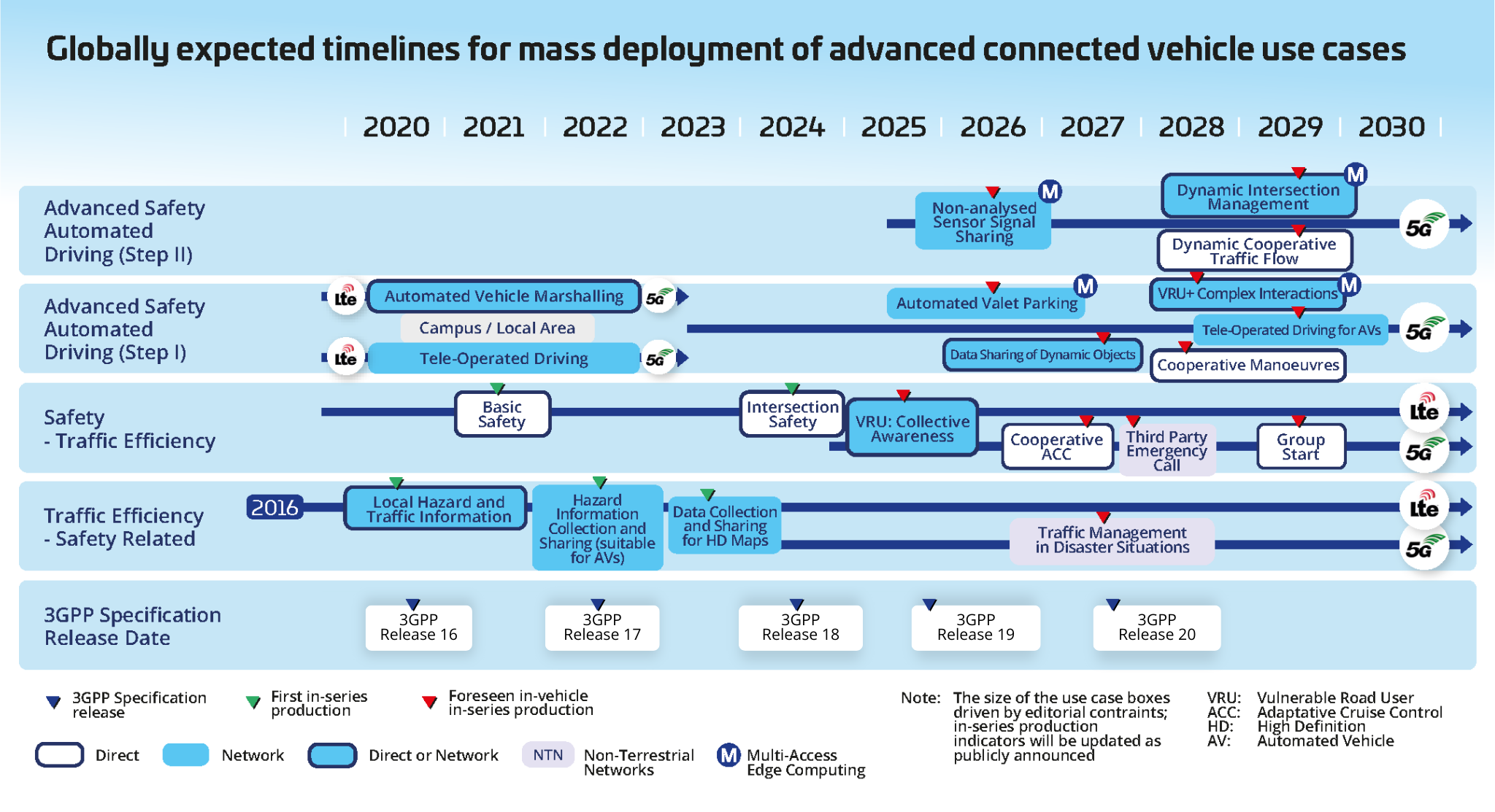

Connected mobility
C-V2X in action
Immerse yourself in the possibilities
The C-V2X technology revolutionises the mobility ecosystem and how drivers interact with the world. It is essential to redefine transportation by providing real-time, highly reliable, and actionable information flows to enable safety, mobility and environmental applications.
5GAA established C-V2X as the critical technology to achieve the level of connectivity required for V2X communication and to be a disruptive force in the automotive market.
C-V2X Testing and Deployment
Following extensive validation testing, off-the-shelf LTE-V2X chipsets, modules, On-Board Units (OBU) and RSU (Roadside Units) have been globally available from multiple vendors since 2018.
These devices feature LTE-V2X direct communications (PC5) and LTE-V2X mobile network communications (Uu). The latest generation of devices features 5G-V2X mobile network communications (Uu) based on 3GPP Release 15.
5GAA regularly compiles an overview of the C-V2X Devices, which we understand are already publicly available on the market (the latest issue in November 2021). This overview is based on publicly available information and does not necessarily include factory-fit telematics/V2X boxes directly under contract with automakers.
The start of in-vehicle commercial deployment (i.e. type-approved vehicles) has begun in 2020-2021. A significant testing schedule is already underway for 5G-V2X, the next generation for cellular technology-based communications solutions, with more than 20 trials and early deployments globally.

Connected Mobility
C-V2X explained
Cellular Vehicle-to-Everything, or C-V2X, is a connected mobility platform that allows vehicles to interact with their surroundings, such as other vehicles, cyclists, pedestrians, road infrastructure, or mobile networks.
To enable connectivity within the broader transport ecosystem, C-V2X uses two complementary transmission modes.
First, direct communications (PC5) works independently of cellular networks and allows vehicles to communicate with other road users (cyclists, pedestrians or other vehicles). Second, network communications (Uu) leverages conventional mobile networks to enable vehicles to receive real-time information about road conditions and local traffic.
By connecting individual vehicles and enabling the development of cooperative intelligent transport systems that reduce congestion and pollution, C-V2X can transform how we look at traffic information to enhance travel and increase road safety.
Leading the new era
of mobility
C-V2X continually evolves over multiple releases in 3GPP. Cellular-V2X (C-V2X) is the umbrella term which encapsulates all 3GPP V2X technologies, including both direct (PC5) and mobile network communications (Uu).
A major milestone was achieved in 2017 by completing LTE-V2X in Release 14, including both direct and mobile network communications delivering basic safety use cases. In 2020, 5G-V2X was completed in Release 16, also combining direct and mobile network communications to enable advanced and automated driving use cases.
Who is 3GPP?
3GPP is a worldwide Standardisation Development Organisation (SDO) developing standards for the different generations of mobile networks: GSM (2G), UMTS (3G), LTE (4G) and 5G, targeting a wide range of consumer and industry applications. When applied in a vehicle connectivity context the acronym V2X (vehicle-to-everything) is added.
C-V2X in detail
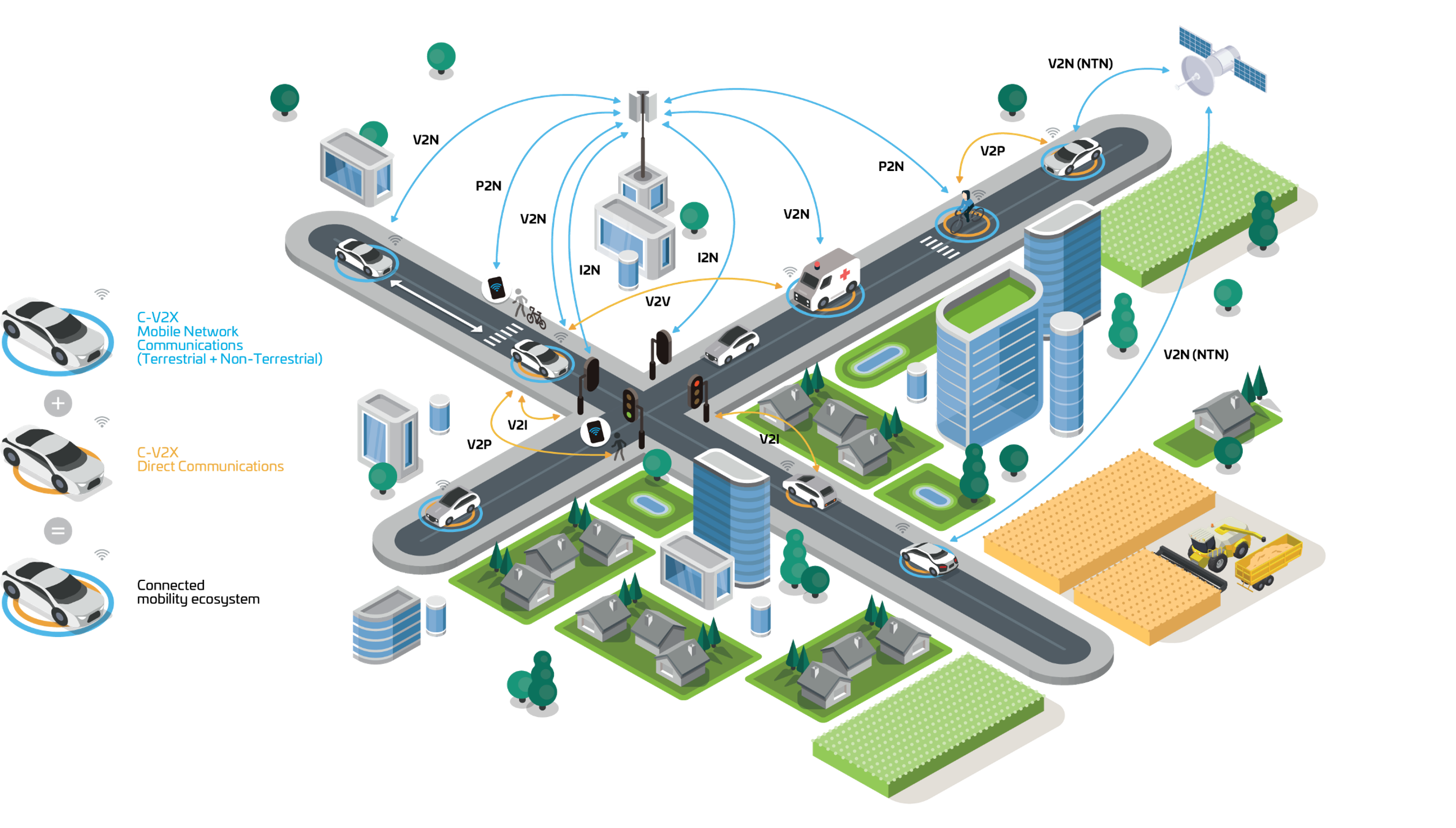
C-V2X provides one unified solution for V2V (vehicle-to-vehicle), V2I (vehicle-to-infrastructure), and V2P (vehicle-to pedestrian) operation with V2N (vehicle-to-network) by leveraging existing cellular network infrastructure.
- Device-to-device [1] is Vehicle-to-Vehicle (V2V), Vehicle-to-(Roadway) Infrastructure (V2I) and Vehicle-to-Pedestrian (V2P) direct communication without necessarily relying on network involvement for scheduling.
- Device-to-cell tower is another communications link that enables network resources and scheduling and utilises existing operator infrastructure. Device-to-cell tower communications constitute at least part of the V2I proposition and are essential to end-to-end solutions.
- Device-to-network is the V2N solution using traditional cellular links to enable cloud services to be part and parcel of the end-to-end solution.
In the device-to-device mode (V2V, V2I, V2P) operation, C-V2X does not necessarily require any network infrastructure. It can operate without a SIM, without network assistance and uses GNSS as its primary time synchronisation source.
C-V2X also supports V2N applications using existing cellular networks where other voices and data communications occur. V2N would deliver network assistance and commercial services requiring the involvement of a Mobile Network Operator (MNO).
Collectively, the transmission modes of shorter-range direct communications (V2V, V2I, V2P) and longer-range network-based communications (V2N) comprise what we call Cellular-V2X[2].
[1] Relies on the PC5 interface specified by 3GPP for device-to-device operation.
[2] See 3GPP TR 22.885 Study on LTE Support for Vehicle to Everything (V2X) Services.

Work Items
Completed Work Items – 2024
Objectives:
- Explore use cases, system requirements, and deployment options for integrating Vehicle-to-Everything (V2X) communication technologies with infrastructure sensors.
- Outline a framework for developing interoperable, standardised solutions that can operate efficiently within existing Intelligent Transportation System (ITS) spectrums.
Objective:
- Provide an update of 5GAA’s vision for the global deployment of smarter, safer and more sustainable mobility and transportation services.
Objectives:
- Provide the state of the art including demonstrations and market status, regulation, and safety-related aspect regarding uncrewed ground robots (UGRs) as well as common analysis and system/component requirements for UGRs.
- Show the methods of communication between UGRs and road users in view of existing gaps in ITS standards, to identify a way forward to incorporate UGRs in future standards.
Objective:
- Outline a vision for integrating a Non-Terrestrial Network (NTN) connectivity layer as a complement to Terrestrial Networks (TN), enhancing coverage and services for connected vehicles.
Objectives:
- Build on previous work in 5GAA on the topic of VRUs, focussing on co-existence and interoperability between different companies’ solutions.
- Previous showcases and demonstrations have shown the functionality and safety benefits of VRU protection solutions, whereas the objective of VRU-DEMO is to show how these solutions are able to interact with each other.
Objective:
- Explore how to manage misbehaviour in Vehicle-to-Everything (V2X) communication systems, where vehicles and infrastructure directly exchange information.
Objectives:
- Provide a business perspective on the Vehicle-to-Network-to-Everything (V2N2X) market, covering market value, stakeholder needs, market growth drivers, and business models observed in various deployments.
- The report complements the high-level V2N2X architecture described in the 5GAA white paper ‘Road traffic operation in a digital age’ and the technical report ‘Vehicle-to-Network-to-Everything (V2N2X) Communications; Architecture, Solution Blueprint, and Use Case Implementation Examples.’
Objectives:
- Describe an ecosystem for stakeholders on how to realise various V2X applications and use cases (UCs), using cellular network communications in combination with information sharing structures between backend systems.
- Clarify the different implementation options of the V2X application in a vehicle and their related implications.
- The report complements the V2N2X business perspectives in the 5GAA white paper ‘Road traffic operation in a digital age’ and the technical report ‘Business Perspectives on Vehicle-to-Network-to-Everything (V2N2X) Deployments’.
Objective:
- Propose a framework for trust assessment within CAVs by defining key terms related to trust and trustworthiness, establishing a foundation for building trust between these vehicles and creating a taxonomy for classifying different trust relationships.
Objectives:
- Develop a methodology specifically for testing vehicular communication antennas and provide validation measures that account for the unique form factors and characteristics of each vehicle.
- This document is an updated version of the Vehicular Antenna Test Methodology technical report published by 5GAA in 2021, available here.
Objectives:
- Reflect the automotive and connectivity industries agreement on spectrum allocation for ITS services in the 5.9 GHz band in Europe.
- This 5GAA position paper also takes into account the updates from ETSI and CEPT and proposes a deployment band configuration for road-ITS in the 5.9 GHz band.
Objectives:
- Propose a transformative approach for automotive stakeholders, emphasizing scalable digital data exchange and a federated architecture to manage road traffic information efficiently.
- Recommend a National Roadway Digital Strategy, federated information-sharing structures, and aligned investments.
Objective:
- Provide an overview of how security, privacy, and data quality are addressed for C-V2X using mobile network and backend communications, also known as Vehicle-to-Network-to-Everything (V2N2X) solutions.
Objective:
- The overview of cellular vehicle-to-everything (C-V2X) devices provides a fresh look at the devices currently available on the market or nearing release to capture the evolving C-V2X device landscape.
Completed Work Items – 2023
Objectives:
- Work with the Connected Motorcycle Consortium (CMC) to identify potential C-V2X technology solutions for
- use cases for powered two-wheelers, focusing on safety aspects
- This includes use cases enabled by external connectivity or sensors but also covers use cases that may profit or be enabled by the presence of external computing power, representing an attractive potential market even with low V2X penetration.
Objectives:
- Identify and evaluate a selection of evolving and emerging technologies for positioning in line with the 5GAA roadmap for use automotive use cases.
- Perform a gap analysis based on automotive use cases concerning selected technologies and provide feedback to relevant SDOs.
Objectives:
- Cover a broad range of topics, ranging from the analysis of MEC-relevant use cases and requirements, both from a technical and business perspective, the collaboration with SDOs and industry groups (GSMA), the definition of a reference architecture with related deployment scenarios, an early study on security and privacy aspects, and the drafting of a plan for future experimental activities on MEC for automotive services, including public demos.
Objective:
- Highlight the vast array of new business opportunities that 5G will enable for the connected mobility ecosystem by moving the discussion beyond safety and automated driving to other innovative solutions and customer experiences.
Objective:
- Consider realistic evaluation assumptions based on a common understanding between the automotive industry and 5G-V2X technology vendors.
Objectives:
- Address the issue of trustworthiness in relation to position information exchanged in the context of V2X communication(how much trust the ITS station can place on the received V2X message containing the positioning information).
- Provide an overview of the current standards related to positioning, including the integrity of the position and confidence levels, and review the definitions and metrics used so far.
Objective:
- Develop and socialise guidance documents on C-V2X direct communications RSU deployment in the USA with a focus on Day 1 (messages, minimum performance, interoperability and certification) to foster real-world infrastructure deployments.
Objectives:
- Accelerate the understanding and adoption of VRU protection services enabled by C-V2X to meet the 5GAA-proposed roadmap for deploying those services.
- This objective is addressed by experimentation and demonstrating existing technology and standards. Exploiting and analysing the results of the experiments and demonstrations enabled an assessment of the existing standards and potential standardisation gaps, laying the ground for the mass deployment of VRU protection services.
Completed Work Items – 2022
Objectives:
- Stimulate auto industry awareness in Conformity Assessment (CA) and conduct a study of current CA schemes being developed by global industry organizations.
- Develop a framework for a harmonized conformance assessment for PC5 applicable to both roadside units and on-board units and attain support from global industry bodies and stakeholders
Objectives:
- Define use cases and align the Use Case Roadmap for mass-market deployment of advanced driving use cases, including their technology and spectrum requirements.
Objectives:
- Analyze the feasibility of distributed vehicle antennas from an implementation perspective and develop measurement strategies for the analysis.
- Analyze the specification impact and the potential necessary changes, and provide output to relevant standardization organizations for possible requirements recommendations.
Objectives:
- Secure consumer acceptance and trust in V2X technologies, and perform lawful processing of data while preserving system efficiency to deliver upon the benefits of both basic and advanced V2X services.
Objectives:
- Produce a report which describes the actions which 5GAA and its members would need to take to ensure that relevant ETSI and CEPT deliverables are created as needed to support the 5GAA C-V2X Roadmap.
Objectives:
- Provide awareness of the current state of misbehaviour developments in standards developing organizations, and propose action items to fill the existing gaps.
Objectives:
- Continue incubation of new technical enablers, both use case specific and use case agnostic, with the intent of achieving sufficient maturity for transition to standards developing organizations .
- Contribute to SDOs via a Liaison member, bringing up new developments in foundational enablers and protocols for review and consumption by TCs & TFs.
Objectives:
- Review and update the specified methodology for the use case analysis for Predictive Quality of Service (QoS) related Service Level Requirements.
- Develop potential enhancements to interfaces, signalling and architecture of the Predictive Quality of Service (QoS) system, including but not limited to the aspects related to edge cloud and interoperability.
Objectives:
- Detect, propose and evaluate possibilities for telecommunication operators, vendors and further stakeholders to provide what is necessary in order to enable the car OEM to better treat safety.
- Investigate processes and tools used to develop and operate the complete chain of the system, deriving a judgement on feasibility of those processes for safety.
Objectives:
- Monitor the activities of standards developing organizations and provide regular updates of the ecosystem to 5GAA members to enable an early identification of risks and challenges in standardization.
Objectives:
- Introduce tele-operation service provider relevant use cases and scenarios with a V2N2V nature and identify gaps and develop architecture solutions for the development of tele-operated driving services
- Study framework requirements of a tele-operation service between vehicle and remote tele-operation centre in cross-mobile network operators, cross-original equipment manufacturers and cross-authority scenarios.
Objectives:
- Produce a C-V2X tolling white paper using the experience from the technology and cost analysis to show the tolling industry how to find common benefit in C-V2X and the importance of C-V2X in the future Road Digitalization Roadmap.
Objectives:
- Establish use case implementation descriptions realizing use cases’ Service Level Requirements for Automated Valet Parking (AVP), Informative Sensor sharing (HD map Collecting and Sharing), Sensor Sharing for Automated vehicles (AVs) and HD Sensor Sharing for AVs.
- Contribute to overarching application system implementation specifications combining the respective use case implementation specifications, including potential interfaces to network layer and security layer.
Objectives:
- Update and improve use case descriptions and corresponding Service Level Requirements in already published Technical Reports and White Papers.
- Collect, harmonize, align, and integrate new use case descriptions developed in 5GAA and publish the third volume of the Technical Report on C-V2X Use Cases and Service Level Requirements.
Objectives:
- Strengthen 5GAA members’ understanding of the state of play of V2X in China and improve the cooperation with and among Chinese members.
Objectives:
- Publish an industry specification defining a system profile to enable US deployment of interoperable basic safety services using LTE-V2X direct communication over channel 183.
Objectives:
- Establish qualitative general, functional and operational requirements to describe systems for the 5G evolution and beyond that would be useful for automotive solutions.
- Provide a unified 5GAA opinion on evolving technologies and the expected transition path for the automotive ecosystem when moving from current 5G technology to its evolution, including potential threats and opportunities.
Completed Work Items – 2021
Objectives:
- Gather evidence of the environmental benefits associated with C-V2X and assist in developing this evidence into a compelling narrative.
- Assess the benefits of C-V2X deployment (both LTE-V2X and 5G-V2X direct and network-based communications) in terms of emission reduction by 2050 in Europe (and for US and Asia) considering various positive and negative externalities.
Objectives:
- Identify and investigate further potential enhancements needed to provide Predictive Quality of Service (QoS) for C-V2X, investigate interoperability of network slices, and provide relevant recommendations to standards developing organizations (SDOs) and industry forums, e.g. 3GPP, ETSI, ISO and GSMA.
Objectives:
- Demonstrate the use of multi-access edge computing (MEC) technology for automotive services, for example, when two distinct automotive vendors can truly test at least three use cases involving two distinct mobile network operators (MNOs) employing the network infrastructure provided by two distinct infrastructure vendors.
- Increase the flexibility of the current network service architecture, reduce the deployment effort, and increase the interoperability among different stakeholders in the system.
Objectives:
- Describe how existing 3GPP methods reduce and improve service interruption due to network reselection.
- Provide an original equipment manufacturer (OEM) view on current and desired network reselection.
Objective:
- Close the gap of the first spectrum needs study by analyzing several advanced use cases and consider additional items such as security overheads in a second release.
Objective:
- Prepare a report which describes the 5GAA’s 5.9 GHz radio channel deployment options for use by LTE-V2X and NR-V2X across all regions, and describe relevant changes to existing regulatory frameworks – or the introduction of new regulatory frameworks – which may be required across all regions.
Objectives:
- Update Use Case Technical Reports with updated use case descriptions and develop a white paper for the Wave 2 of use cases.
- Provide a new set of use cases with their corresponding service level requirements (SLRs) to be summarized into a new TR.
Objectives:
- Study and describe specific and technology dependent use case implementations that fulfil the service level requirements (SLRs) as defined in the technology agnostic 5GAA use case descriptions.
- Develop corresponding descriptions for three exemplary use cases: Left Turn Assist (LTA), (Electronic) Emergency Brake (light) Warning (EEBL), and Traffic Jam Warning and Route Information.
Objective:
- Define a standardized test method and metrics for vehicular antennas with the dominant emittance toward the outside of the vehicle, focusing on vehicular antennas for telecommunications (2G, 3G, 4G, 5G (< 7.125GHz)), vehicular antennas for direct communication between vehicles to road infrastructure (operating in the designated ITS frequency spectrum (5.9GHz range)), GNSS antennas and 3D-measurements (vehicle-mounted antenna element)
Objectives:
- Focus on positioning method for vehicles and vulnerable road users (VRUs) and study both positioning methods employing cellular signals (5G/LTE/C-V2X) and the positioning methods integrated with other technologies.
- Study the requirements of positioning, build the understanding of positioning system framework, and offer the corresponding technologies according to the requirements and environments.
Completed Work Items – 2020
Objective:
- Analyze V2I deployment costs, including financial, economic and market aspects, to provide guidance to regulators, policymakers and other key stakeholders.
- Analyse options with higher and lower levels of V2I-based infrastructure vs. V2N-based approach.
Objective:
- Define and analyse the automotive use case requirements in terms of Quality of Service (QoS) using network slicing and analyze business value and identify the specific features required to support the automotive use cases that cover IoT and mobile broadband services.
Objectives:
- Define use cases and align the Use Case Roadmap for mass-market deployment of advanced driving use cases, including their technology and spectrum requirements.
Map, assess and contribute to the identification of technical gaps (upper and lower layers, e.g. protocols, Rel. 18 requirements) and forward to relevant standards setting organizations (SSOs).
Objectives:
- Define all necessary details for conducting the first 5GAA C-V2X Plugfest in the first quarter of 2019.
- Define 5GAA requirements and timelines for conducting successive plugfests after the first quarter of 2019.
Objective:
- Facilitate a harmonized industrial evolution and development of enhanced cellular V2X, starting with supporting the basic use cases with the already available C-V2X technologies such as 3GPP Rel-14/15 C-V2X and adopt new technologies for the use cases which cannot be served with current C-V2X
Objectives:
- Establish a lightweight security system for C-V2X/5G-V2X communications by conducting a requirements analysis of regional privacy regulations to establish an overview of regional differences and define requirements for each region.
- Analyze concepts to simplify the architecture and its impact on regional privacy compliance.
Objectives:
- Identify structured and reasonable requirements on mobile networks relevant to spectrum auctioning to accommodate automotive use cases and enable mobile network operator (MNOs) to quantify associated investments.
- Analyze licensed spectrum auctioning frameworks and other incentivizing initiatives, such as infrastructure leasing exceptions, where additional investments required by mobile network operators (MNOs) to fulfill requirements associated to automotive use cases are appropriately recognized.
Objectives:
- Develop application-level groundwork for the next-generation services (Rel-16) with use cases involving complex message interactions for assisted and autonomous (Ll1-Ll5) and automated driving (supported by infrastructure).
- Build prototypes and demonstrate next-generation applications (Rel-16 and further) to gain hands-on experience with some use cases to help stakeholders (OEMs, suppliers, road operators, regulators) understand how 5G NR can implement the concept of connected and automated vehicles for proximal vehicle-to-X coordination and cooperation.
Objective:
- Solicit road operators’ views on their role in the deployment of ITS C-V2X services through a free form questionnaire to determine the road operator willingness to participate directly in future 5GAA discussions or events.
Objectives:
- Develop and demonstrate a phased vulnerable road user (VRU) protection approach by defining a VRU protection roadmap.
- Provide realistic paths for vulnerable road user (VRU) protection using cellular communications, differentiating C-V2X from 802.11p based technologies and set the stage for application of C-V2X to VRU protection.
Objectives:
- Define the application layer reference architecture for the V2X service and recommend the application layer reference architecture of the V2X system.
- Discuss other architecture related subjects to align with the coordinated 5GAA architecture.
Completed Work Items – 2019
Objective:
- Identify, analyze and compare the advantages and disadvantages of V2I deployment using long-range (Uu) mobile networks and RSU (PC5) from a business perspective, reflecting how C-V2X enables synergies with both the transportation and telecommunications infrastructure, which includes leveraging existing mobile network infrastructure for C-ITS.
Objectives:
- Work on the CEPT/ETSI-related activities by extending the ITS safety-related band at 5.9 GHz to allow coexistence of LTE V2X and Urban Rail to coexist with ITS-G5 within the 5,875-5,925 MHz frequency band.
- Clarify ITS “co-frequency coexistence” statements, include future 3GPP releases and evolution, engage the urban rail community, engage with national administrations.
Objectives:
- Develop a trial and interoperability testing framework that defines the deployment scenarios and uses cases, testing methodologies, key performance indicators (KPIs) to be tested.
- Develop a 5GAA trial and interoperability testing strategy to capture the 5GAA testing priorities, including setting up a 5GAA testbed environment and planning multi-partner trials covering the priority test cases.
Objective:
- Prepare input material for the work in ETSI TC ITS to amend the test specification required to use LTE-V2X as the underlying access layer technology.
Objectives:
- Identify and evaluate potential architecture enhancements needed to provide predictable Quality of Service (QoS) for C-V2X in 5G for the automotive industry, utilizing network slicing and edge computing technologies.
- Provide guidelines on the design of Network Slice Templates (NST) for the automotive industry that enable support for different categories of C-V2X use cases and 5GAA requirements.
Objectives:
- Provide an assessment of the deployment roadmap for use cases.
- Establish a mapping between use cases and potential technology candidates, e.g. 3GPP releases, sidelink and/or Uu requirements.
Objectives:
- Define a framework for classifying use cases and requirements, identify prioritized use cases, functional requirements and key performance indicators (KPIs).
- Perform a gap analysis and specify the extended set of prioritized use cases.
Objectives:
- Identify the use cases that benefited from the presence of an application server, and based on the output, explore the V2X application server features and how the application server can be used to perform these use cases.
Completed Work Items – 2018
Objectives:
- Develop consensus on operating models for system implementation, taking into account the various requirements arising from the planned networked transport services.
- Investigate architectural paradigms such as cloud-based solutions, including edge computing aspects, and analyze solutions from the perspective of verification, confidentiality and privacy, identify requirements and key performance indicators (KPIs), and recommend further actions.
Objective:
- Enable the development of a strategy for comprehensive testing, trials, demo pilots, and compliance assessment for V2X using cellular air interface specifications (i.e., including PC5 and Uu).
Objectives:
- Promote C-V2X, including existing (LTE-V2X PC5 and Uu interfaces) and future realizations, as the technology of choice for ITS and promote ITS in 5.9 GHz spectrum in some areas, and interact various regulatory organizations.
- Comment FO: This WI did not have an acronym.
Objectives:
- Promote C-V2X, including its existing (LTE-V2X) and future realizations, as the technology of choice for ITS.
- Promote appropriate availability of radio spectrum for C-V2X where necessary in addition to 5.9 GHz, and promote the use of 5.9 GHz for safety-related ITS over other applications (e.g., RLANs, CBTC).
- Comment FO: This WI did not have an acronym.
Objectives:
- Quantify the future spectrum needs for 5G short-range V2X communications in the context of safety-related ITS spectrum allocation and 5G wide range communications.
- Comment FO: This WI did not have an acronym.
Objectives:
- Develop recorded test procedures to validate various performance and functional requirements of C-V2X technology covering both the laboratory/test bed and the field test environments.
Objectives:
- Quantify future spectrum needs for 5G V2X communications related to ITS spectrum allocation for advanced use cases, including a technology assessment of the amount of radio spectrum needed to meet the key performance criteria related to the low frequency band (e.g. 5.9 GHz) as well as mmWave (e.g. 63–64 GHz) for various advanced ITS applications and a wide-area 4G/5G Uu interface.
- Comment FO: This WI did not have an acronym.
Completed Work Items – 2017
Objective:
- Establish a high-level plan for C-V2X trials in North America, including definition of trial scope and objectives, identification of suitable/preferred trial facilities, and guidance regarding preferred trial participant composition.
Objective:
- Identify existing regional V2X application specifications that have some dependency on specific radio access technologies, such as ITS-G5/11p, and determine how these specifications can be adapted to interoperate with generic radio access technologies and, in particular, with the lower layers of ITS-Cellular specified by 3GPP.
Objective:
- Develop the timeline of major functionalities and milestones describing the expected availability of monetizable items and associated business and/or operational model options.
Objectives:
- Identify sensor data sharing requirements from planned automated driving applications, including architecture options, requirements and implications.
- Conduct a gap analysis of ETSI ITS standards related to existing data objects and complete a technical report outlining the 5GAA framework for sensor data sharing for V2X applications.
Objective:
- Prepare a survey report on finalized, on-going and planned test activities, established testbeds and simulation frameworks.
Objective:
- Compile V2X communication terms and definitions to be used within the 5GAA.
Completed Work Items – 2023
Objectives:
- Work with the Connected Motorcycle Consortium (CMC) to identify potential C-V2X technology solutions for
- use cases for powered two-wheelers, focusing on safety aspects
- This includes use cases enabled by external connectivity or sensors but also covers use cases that may profit or be enabled by the presence of external computing power, representing an attractive potential market even with low V2X penetration.
Objectives:
- Identify and evaluate a selection of evolving and emerging technologies for positioning in line with the 5GAA roadmap for use automotive use cases.
- Perform a gap analysis based on automotive use cases concerning selected technologies and provide feedback to relevant SDOs.
Objectives:
- Cover a broad range of topics, ranging from the analysis of MEC-relevant use cases and requirements, both from a technical and business perspective, the collaboration with SDOs and industry groups (GSMA), the definition of a reference architecture with related deployment scenarios, an early study on security and privacy aspects, and the drafting of a plan for future experimental activities on MEC for automotive services, including public demos.
Objectives:
- Highlight the vast array of new business opportunities that 5G will enable for the connected mobility ecosystem by moving the discussion beyond safety and automated driving to other innovative solutions and customer experiences.
Objectives:
- Address the operational aspects of misbehaviour detection, explicitly looking into remediation classification, misbehaviour classification and misbehaviour remediation.
Objectives:
- Analyse and evaluate the performance of 3GPP NR-V2X sidelink and draw conclusions and recommendations for its operation, including gap analysis covering future releases and engagements with relevant SDOs.
Objectives:
- Address the issue of trustworthiness in relation to position information exchanged in the context of V2X communication(how much trust the ITS station can place on the received V2X message containing the positioning information).
- Provide an overview of the current standards related to positioning, including the integrity of the position and confidence levels, and review the definitions and metrics used so far.
Objectives:
- Develop and socialise guidance documents on C-V2X direct communications RSU deployment in the USA with a focus on Day 1 (messages, minimum performance, interoperability and certification) to foster real-world infrastructure deployments.
Objectives:
- Accelerate the understanding and adoption of VRU protection services enabled by C-V2X to meet the 5GAA-proposed roadmap for deploying those services.
- This objective is addressed by experimentation and demonstrating existing technology and standards. Exploiting and analysing the results of the experiments and demonstrations enabled an assessment of the existing standards and potential standardisation gaps, laying the ground for the mass deployment of VRU protection services.
Completed Work Items – 2022
Objectives:
- Stimulate auto industry awareness in Conformity Assessment (CA) and conduct a study of current CA schemes being developed by global industry organizations.
- Develop a framework for a harmonized conformance assessment for PC5 applicable to both roadside units and on-board units and attain support from global industry bodies and stakeholders
Objectives:
- Define use cases and align the Use Case Roadmap for mass-market deployment of advanced driving use cases, including their technology and spectrum requirements.
Objectives:
- Analyze the feasibility of distributed vehicle antennas from an implementation perspective and develop measurement strategies for the analysis.
- Analyze the specification impact and the potential necessary changes, and provide output to relevant standardization organizations for possible requirements recommendations.
Objectives:
- Secure consumer acceptance and trust in V2X technologies, and perform lawful processing of data while preserving system efficiency to deliver upon the benefits of both basic and advanced V2X services.
Objectives:
- Produce a report which describes the actions which 5GAA and its members would need to take to ensure that relevant ETSI and CEPT deliverables are created as needed to support the 5GAA C-V2X Roadmap.
Objectives:
- Provide awareness of the current state of misbehaviour developments in standards developing organizations, and propose action items to fill the existing gaps.
Objectives:
- Continue incubation of new technical enablers, both use case specific and use case agnostic, with the intent of achieving sufficient maturity for transition to standards developing organizations .
- Contribute to SDOs via a Liaison member, bringing up new developments in foundational enablers and protocols for review and consumption by TCs & TFs.
Objectives:
- Review and update the specified methodology for the use case analysis for Predictive Quality of Service (QoS) related Service Level Requirements.
- Develop potential enhancements to interfaces, signalling and architecture of the Predictive Quality of Service (QoS) system, including but not limited to the aspects related to edge cloud and interoperability.
Objectives:
- Detect, propose and evaluate possibilities for telecommunication operators, vendors and further stakeholders to provide what is necessary in order to enable the car OEM to better treat safety.
- Investigate processes and tools used to develop and operate the complete chain of the system, deriving a judgement on feasibility of those processes for safety.
Objectives:
- Monitor the activities of standards developing organizations and provide regular updates of the ecosystem to 5GAA members to enable an early identification of risks and challenges in standardization.
Objectives:
- Introduce tele-operation service provider relevant use cases and scenarios with a V2N2V nature and identify gaps and develop architecture solutions for the development of tele-operated driving services
- Study framework requirements of a tele-operation service between vehicle and remote tele-operation centre in cross-mobile network operators, cross-original equipment manufacturers and cross-authority scenarios.
Objectives:
- Produce a C-V2X tolling white paper using the experience from the technology and cost analysis to show the tolling industry how to find common benefit in C-V2X and the importance of C-V2X in the future Road Digitalization Roadmap.
Objectives:
- Establish use case implementation descriptions realizing use cases’ Service Level Requirements for Automated Valet Parking (AVP), Informative Sensor sharing (HD map Collecting and Sharing), Sensor Sharing for Automated vehicles (AVs) and HD Sensor Sharing for AVs.
- Contribute to overarching application system implementation specifications combining the respective use case implementation specifications, including potential interfaces to network layer and security layer.
Objectives:
- Update and improve use case descriptions and corresponding Service Level Requirements in already published Technical Reports and White Papers.
- Collect, harmonize, align, and integrate new use case descriptions developed in 5GAA and publish the third volume of the Technical Report on C-V2X Use Cases and Service Level Requirements.
Objectives:
- Strengthen 5GAA members’ understanding of the state of play of V2X in China and improve the cooperation with and among Chinese members.
Objectives:
- Publish an industry specification defining a system profile to enable US deployment of interoperable basic safety services using LTE-V2X direct communication over channel 183.
Objectives:
- Establish qualitative general, functional and operational requirements to describe systems for the 5G evolution and beyond that would be useful for automotive solutions.
- Provide a unified 5GAA opinion on evolving technologies and the expected transition path for the automotive ecosystem when moving from current 5G technology to its evolution, including potential threats and opportunities.
Completed Work Items – 2021
Objectives:
- Gather evidence of the environmental benefits associated with C-V2X and assist in developing this evidence into a compelling narrative.
- Assess the benefits of C-V2X deployment (both LTE-V2X and 5G-V2X direct and network-based communications) in terms of emission reduction by 2050 in Europe (and for US and Asia) considering various positive and negative externalities.
Objectives:
- Identify and investigate further potential enhancements needed to provide Predictive Quality of Service (QoS) for C-V2X, investigate interoperability of network slices, and provide relevant recommendations to standards developing organizations (SDOs) and industry forums, e.g. 3GPP, ETSI, ISO and GSMA.
Objectives:
- Demonstrate the use of multi-access edge computing (MEC) technology for automotive services, for example, when two distinct automotive vendors can truly test at least three use cases involving two distinct mobile network operators (MNOs) employing the network infrastructure provided by two distinct infrastructure vendors.
- Increase the flexibility of the current network service architecture, reduce the deployment effort, and increase the interoperability among different stakeholders in the system.
Objectives:
- Describe how existing 3GPP methods reduce and improve service interruption due to network reselection.
- Provide an original equipment manufacturer (OEM) view on current and desired network reselection.
Objective:
- Close the gap of the first spectrum needs study by analyzing several advanced use cases and consider additional items such as security overheads in a second release.
Objective:
- Prepare a report which describes the 5GAA’s 5.9 GHz radio channel deployment options for use by LTE-V2X and NR-V2X across all regions, and describe relevant changes to existing regulatory frameworks – or the introduction of new regulatory frameworks – which may be required across all regions.
Objectives:
- Update Use Case Technical Reports with updated use case descriptions and develop a white paper for the Wave 2 of use cases.
- Provide a new set of use cases with their corresponding service level requirements (SLRs) to be summarized into a new TR.
Objectives:
- Study and describe specific and technology dependent use case implementations that fulfil the service level requirements (SLRs) as defined in the technology agnostic 5GAA use case descriptions.
- Develop corresponding descriptions for three exemplary use cases: Left Turn Assist (LTA), (Electronic) Emergency Brake (light) Warning (EEBL), and Traffic Jam Warning and Route Information.
Objective:
- Define a standardized test method and metrics for vehicular antennas with the dominant emittance toward the outside of the vehicle, focusing on vehicular antennas for telecommunications (2G, 3G, 4G, 5G (< 7.125GHz)), vehicular antennas for direct communication between vehicles to road infrastructure (operating in the designated ITS frequency spectrum (5.9GHz range)), GNSS antennas and 3D-measurements (vehicle-mounted antenna element)
Objectives:
- Focus on positioning method for vehicles and vulnerable road users (VRUs) and study both positioning methods employing cellular signals (5G/LTE/C-V2X) and the positioning methods integrated with other technologies.
- Study the requirements of positioning, build the understanding of positioning system framework, and offer the corresponding technologies according to the requirements and environments.
Completed Work Items – 2020
Objective:
- Analyze V2I deployment costs, including financial, economic and market aspects, to provide guidance to regulators, policymakers and other key stakeholders.
- Analyse options with higher and lower levels of V2I-based infrastructure vs. V2N-based approach.
Objective:
- Define and analyse the automotive use case requirements in terms of Quality of Service (QoS) using network slicing and analyze business value and identify the specific features required to support the automotive use cases that cover IoT and mobile broadband services.
Objectives:
- Define use cases and align the Use Case Roadmap for mass-market deployment of advanced driving use cases, including their technology and spectrum requirements.
Map, assess and contribute to the identification of technical gaps (upper and lower layers, e.g. protocols, Rel. 18 requirements) and forward to relevant standards setting organizations (SSOs).
Objectives:
- Define all necessary details for conducting the first 5GAA C-V2X Plugfest in the first quarter of 2019.
- Define 5GAA requirements and timelines for conducting successive plugfests after the first quarter of 2019.
Objective:
- Facilitate a harmonized industrial evolution and development of enhanced cellular V2X, starting with supporting the basic use cases with the already available C-V2X technologies such as 3GPP Rel-14/15 C-V2X and adopt new technologies for the use cases which cannot be served with current C-V2X
Objectives:
- Establish a lightweight security system for C-V2X/5G-V2X communications by conducting a requirements analysis of regional privacy regulations to establish an overview of regional differences and define requirements for each region.
- Analyze concepts to simplify the architecture and its impact on regional privacy compliance.
Objectives:
- Identify structured and reasonable requirements on mobile networks relevant to spectrum auctioning to accommodate automotive use cases and enable mobile network operator (MNOs) to quantify associated investments.
- Analyze licensed spectrum auctioning frameworks and other incentivizing initiatives, such as infrastructure leasing exceptions, where additional investments required by mobile network operators (MNOs) to fulfill requirements associated to automotive use cases are appropriately recognized.
Objectives:
- Develop application-level groundwork for the next-generation services (Rel-16) with use cases involving complex message interactions for assisted and autonomous (Ll1-Ll5) and automated driving (supported by infrastructure).
- Build prototypes and demonstrate next-generation applications (Rel-16 and further) to gain hands-on experience with some use cases to help stakeholders (OEMs, suppliers, road operators, regulators) understand how 5G NR can implement the concept of connected and automated vehicles for proximal vehicle-to-X coordination and cooperation.
Objective:
- Solicit road operators’ views on their role in the deployment of ITS C-V2X services through a free form questionnaire to determine the road operator willingness to participate directly in future 5GAA discussions or events.
Objectives:
- Develop and demonstrate a phased vulnerable road user (VRU) protection approach by defining a VRU protection roadmap.
- Provide realistic paths for vulnerable road user (VRU) protection using cellular communications, differentiating C-V2X from 802.11p based technologies and set the stage for application of C-V2X to VRU protection.
Objectives:
- Define the application layer reference architecture for the V2X service and recommend the application layer reference architecture of the V2X system.
- Discuss other architecture related subjects to align with the coordinated 5GAA architecture.
Completed Work Items – 2019
Objective:
- Identify, analyze and compare the advantages and disadvantages of V2I deployment using long-range (Uu) mobile networks and RSU (PC5) from a business perspective, reflecting how C-V2X enables synergies with both the transportation and telecommunications infrastructure, which includes leveraging existing mobile network infrastructure for C-ITS.
Objectives:
- Work on the CEPT/ETSI-related activities by extending the ITS safety-related band at 5.9 GHz to allow coexistence of LTE V2X and Urban Rail to coexist with ITS-G5 within the 5,875-5,925 MHz frequency band.
- Clarify ITS “co-frequency coexistence” statements, include future 3GPP releases and evolution, engage the urban rail community, engage with national administrations.
Objectives:
- Develop a trial and interoperability testing framework that defines the deployment scenarios and uses cases, testing methodologies, key performance indicators (KPIs) to be tested.
- Develop a 5GAA trial and interoperability testing strategy to capture the 5GAA testing priorities, including setting up a 5GAA testbed environment and planning multi-partner trials covering the priority test cases.
Objective:
- Prepare input material for the work in ETSI TC ITS to amend the test specification required to use LTE-V2X as the underlying access layer technology.
Objectives:
- Identify and evaluate potential architecture enhancements needed to provide predictable Quality of Service (QoS) for C-V2X in 5G for the automotive industry, utilizing network slicing and edge computing technologies.
- Provide guidelines on the design of Network Slice Templates (NST) for the automotive industry that enable support for different categories of C-V2X use cases and 5GAA requirements.
Objectives:
- Provide an assessment of the deployment roadmap for use cases.
- Establish a mapping between use cases and potential technology candidates, e.g. 3GPP releases, sidelink and/or Uu requirements.
Objectives:
- Define a framework for classifying use cases and requirements, identify prioritized use cases, functional requirements and key performance indicators (KPIs).
- Perform a gap analysis and specify the extended set of prioritized use cases.
Objectives:
- Identify the use cases that benefited from the presence of an application server, and based on the output, explore the V2X application server features and how the application server can be used to perform these use cases.
Completed Work Items – 2018
Objectives:
- Develop consensus on operating models for system implementation, taking into account the various requirements arising from the planned networked transport services.
- Investigate architectural paradigms such as cloud-based solutions, including edge computing aspects, and analyze solutions from the perspective of verification, confidentiality and privacy, identify requirements and key performance indicators (KPIs), and recommend further actions.
Objective:
- Enable the development of a strategy for comprehensive testing, trials, demo pilots, and compliance assessment for V2X using cellular air interface specifications (i.e., including PC5 and Uu).
Objectives:
- Promote C-V2X, including existing (LTE-V2X PC5 and Uu interfaces) and future realizations, as the technology of choice for ITS and promote ITS in 5.9 GHz spectrum in some areas, and interact various regulatory organizations.
- Comment FO: This WI did not have an acronym.
Objectives:
- Promote C-V2X, including its existing (LTE-V2X) and future realizations, as the technology of choice for ITS.
- Promote appropriate availability of radio spectrum for C-V2X where necessary in addition to 5.9 GHz, and promote the use of 5.9 GHz for safety-related ITS over other applications (e.g., RLANs, CBTC).
- Comment FO: This WI did not have an acronym.
Objectives:
- Quantify the future spectrum needs for 5G short-range V2X communications in the context of safety-related ITS spectrum allocation and 5G wide range communications.
- Comment FO: This WI did not have an acronym.
Objectives:
- Develop recorded test procedures to validate various performance and functional requirements of C-V2X technology covering both the laboratory/test bed and the field test environments.
Objectives:
- Quantify future spectrum needs for 5G V2X communications related to ITS spectrum allocation for advanced use cases, including a technology assessment of the amount of radio spectrum needed to meet the key performance criteria related to the low frequency band (e.g. 5.9 GHz) as well as mmWave (e.g. 63–64 GHz) for various advanced ITS applications and a wide-area 4G/5G Uu interface.
- Comment FO: This WI did not have an acronym.
Completed Work Items – 2017
Objective:
- Establish a high-level plan for C-V2X trials in North America, including definition of trial scope and objectives, identification of suitable/preferred trial facilities, and guidance regarding preferred trial participant composition.
Objective:
- Identify existing regional V2X application specifications that have some dependency on specific radio access technologies, such as ITS-G5/11p, and determine how these specifications can be adapted to interoperate with generic radio access technologies and, in particular, with the lower layers of ITS-Cellular specified by 3GPP.
Objective:
- Develop the timeline of major functionalities and milestones describing the expected availability of monetizable items and associated business and/or operational model options.
Objectives:
- Identify sensor data sharing requirements from planned automated driving applications, including architecture options, requirements and implications.
- Conduct a gap analysis of ETSI ITS standards related to existing data objects and complete a technical report outlining the 5GAA framework for sensor data sharing for V2X applications.
Objective:
- Prepare a survey report on finalized, on-going and planned test activities, established testbeds and simulation frameworks.
Objective:
- Compile V2X communication terms and definitions to be used within the 5GAA.
Active Work Items
This work item will drive the study on the trends and evolution of current technologies. The objectives of the work item consist of:
- Establish qualitative general, functional and operational requirements that would describe systems for the5G evolution and beyond that would be useful for automotive solutions,
- Conduct a SWOT analysis with the automotive industry with respect to evolving technologies in a timeframe of 5, 10 and/or 15 years,
- Providing a unified 5GAA opinion (in the form of a white paper) on evolving technologies and the expected transition path for the Automotive
- Ecosystem when moving from current 5G to its evolution, including the potential threats and opportunities.
This Work Item assesses the required communication technology to support Automated Valet Parking (AVP) as specified by the 5GAA Use Cases T-210023, T-190139 and T-190140 and their respective Service Level Requirements (SLR).
This Work Item assesses the required communication technology to support Automated Valet Parking (AVP) as specified by the 5GAA Use Cases T-210023, T-190139 and T-190140 and their respective Service Level Requirements (SLR).
This Work Item consists of:
- Stimulate Auto Industry awareness in CA
- Study of current CA schemes being developed by global industry organisations
- Develop a framework for harmonized PC5 CA applicable to both RSUs and OBUs and attain support from global industry bodies and stakeholders
This Work Item aims at:
- Create a list of devices and update it every 6 months
- Define KPIs of the Dashboard and the format of the dashboard presentation
- Verify 5GAA’s market predictions
- Ensure legal compliance
- Create the first dashboard for publication
A joint Work Item with the Connected Motorcycle Consortium, this WI will look into CV2X enabled use cases for motorcycles mainly focusing on safety
Definition of all Use Cases and alignment of UC roadmap for mass-market deployment of advanced driving Use Cases, inc. their technology and spectrum requirements.
A comprehensive overview of the privacy and data protection regulatory framework.
A report which describes the actions which 5GAA and its members would need to take in order to ensure that relevant ETSI and CEPT deliverables are created as needed to support the 5GAA C-V2X Roadmap.
Publications
This Work Item consists of:
- Moving toward federated MEC demos/trials (global MEC);
- MEC System interoperability and test framework;
- usage of predictive edge analytics and situation awareness for closed-loop adaptation in multi-MNO and multi-OEM MEC scenarios (synergy and inputs from NESQO,eNESQO,V2XSRA PRESA);
This Work Item aims at discussing attractive selling points for CV2X for both final customers and OEMs beyond the usually discussed ADAS and safety features.
This Work Item:
- Provides awareness of current state of MBD developments in SDOs and trials/demos, and proposes action items to fill the existing gaps.
- Delivers content on: (1) concepts and terms definitions, V2X message stack, (2) overview of related/existing work and gaps, (3) Threat and Risk Assessment (TARA) and requirements for Day-1 applications, (4) determination of application domain-specific mitigation, and (5) legal aspects and recommendation of a strategy.
This Work Item aims at:
- Continue incubation of new technical enablers, both UC specific and agnostic for transition to SDOs.
- Contribute to SDOs via a Liaison member & Individual contributors from member companies will work directly on relevant standards projects on an ongoing basis.
This Work Item consists of:
- Review and update the specified methodology for the UC’ analysis for Predictive QoS related SLRs.
- Study application and system reactions.
- Develop potential enhancements to interfaces, signalling and architecture of the P-QoS system, including but not limited to the aspects related to edge cloud and interoperability.
- Provide input to SDOs.
This Work Item consists of:
- Monitor SDOs activities on and provide regular updates of the ecosystem to 5GAA members. This will enable early identification of risks and challenges in standardisation.
- Prepare contributions by 5GAA to critical SDOs.
- Support WGs and WIs intending to provide inputs to SDOs.
- Support 5GAA messaging in SDO related events.
This Work Item:
- Explore the use of C-V2X to enable electronic toll collection in China (ETC)
- Constructive advice about Investment, Performance Improvement and migration for C-V2X Tolling Implementation in China
- Find common benefits between Road Industries and 5GAA
This Work Item consists of:
- Update White Paper on C-V2X Use Cases: Methodology, Examples and Service Level Requirements [3].
- Update TRs Vol. I [1] and Vol. II [2] as needed.
- Update WP Vol. I [3] and Vol. II [4] as needed.
- Create new TR (Vol. III) with new UCs.
This Work Item consists of:
- Description of applicable measurement configurations
- Description of test procedures
- Definition of relevant metrics
Accelerate the understanding and adoption of VRU protection services enabled by C-V2X” in order to meet the 5GAA-proposed roadmap for the deployment of those services.
Completed Work Items – 2020
Lorem ipsum
Lorem ipsum
Completed Work Items – 2020
Lorem ipsum
Lorem ipsum

Working Groups
5GAA’s short and long term goals contribute to the same ambition: Connected Mobility and touch upon many of the ecosystem’s components.
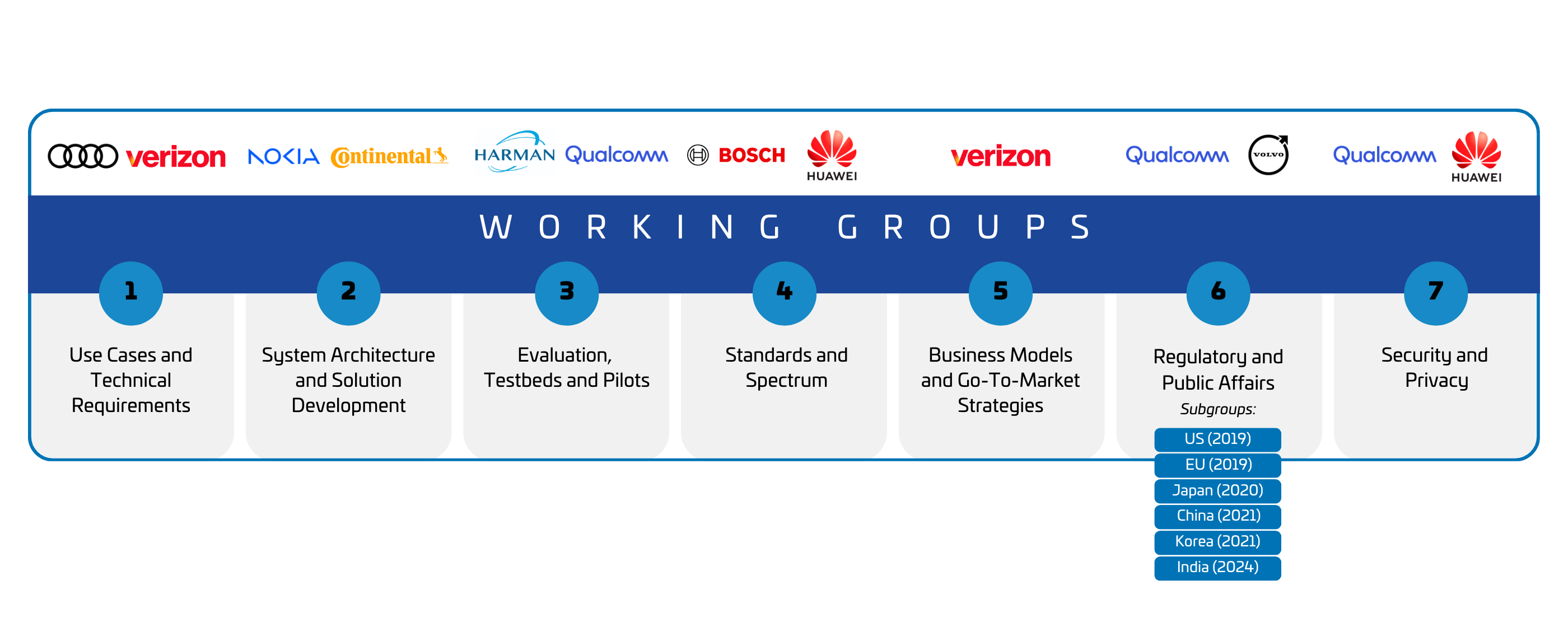
Working Groups
Define end-to-end view on use cases and derive technical requirements and performance indicators for the certification of connected mobility solutions (e.g. on communication architecture, radio protocols, radio parameters, frequency spectra and carrier aggregation combinations). Ensure interoperability for V2X and other affected technologies.
 |
 |
| Julia Rainer (Audi) |
Mu He (Verizon) |
| Chair | Vice-chair |
Define, develop and recommend system architectures and interoperable end-to-end solutions to address use cases and Services of Interest. Reviewing currently available solutions in technical areas such as wireless air interface technologies, wireless network deployment models, radio access networks and networked clouds, connectivity and device management or security, privacy and authentication.
 |
 |
| Berthold Panzner (Nokia) |
Andreas Andrae (Continental Automotive Technologies GmbH) |
| Chair | Vice-chair |
Evaluate and validate end-to-end solutions through testbeds. Globally orchestrating and harmonising conformity and interoperability assessments to ensure that new C-V2X products conform to existing standards and are interoperable with each other. Manage regional interoperability event programmes in cooperation with regionally established organisations. Promote commercialisation and standardisation via pilots and large-scale trials by selecting the use cases in conjunction with go-to-market strategies. This includes multi-phase / multi-year planning with prioritisation.
 |
 |
| Jacob Harel (Harman) |
Ralf Weber (Qualcomm) |
| Chair | Vice-chair |
Act as ‘Industry Specification Group’, providing recommendations, contributions and positions to ETSI, 3GPP and other standards development organisations. Agree on spectrum requirements for V2X in ITS, MBB and unlicensed bands. Represent the association vis-à-vis other industry organisations.
 |
 |
| Khaled Shawky Hassan (Bosch) |
Reza Karimi (Huawei) |
| Chair | Vice-chair |
Agree on criteria for business models. Identify involved organisations and companies, and prioritise them. Draft exemplary go-to-market plan as straw man function for agreed use cases under test and business models. Agree on how to best achieve a global approach to certification of the target connected mobility solutions.
 |
|
| Michael Salmon (Verizon) | |
| Chair |
Agree on common 5GAA positions in relation to policy and regulatory matters at a national, regional and (whenever possible) global level to secure market access, foster technology innovation and investment, and support commercial deployment, developing a common policy strategy among industry stakeholders, public authorities, and subject matter expert members.
 |
 |
| Anne-Lise Thieblemont (Qualcomm) |
Kristina Olausson (Volvo Cars) |
| Chair | Vice-chair |
WG6 – Europe sub-group:
 |
 |
| Anne-Lise Thieblemont (Qualcomm) |
Kristina Olausson (Volvo Cars) |
| Lead | Co-Lead |
WG6 – US sub-group:
 |
 |
| Brad Stertz (Audi) |
Andres Castrillon (Qualcomm) |
| Lead | Co-Lead |
WG6 – China sub-group:
 |
 |
|
| Li Zhao (CATT) |
Yinxiang Zheng (CMCC) |
|
| Lead | Co-Lead |
WG6 – Japan sub-group:
 |
 |
| Hiroki Shibayama (NTT Docomo) |
Masakazu Shirota (Qualcomm) |
| Co-Lead | Co-Lead |
WG6 – Korea sub-group:
 |
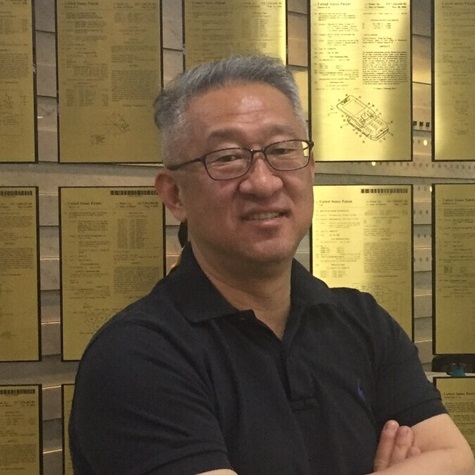 |
| Heejin Kim (LG) |
Michael Park (Qualcomm) |
| Lead | Co-Lead |
WG6 – India sub-group:
 |
 |
| Divya Sachdeva (Ericsson) |
Nitin Sonar (Bosch) |
| Co-Lead | Co-Lead |
Review currently available solutions in relevant technical areas and identify gaps toward comprehensive secure end-to-end solutions and specifications for the use cases and services of interest as defined by the “Use Cases and Technical Requirements” WG.
 |
 |
| Virendra Kumar (Qualcomm) |
Ioannis Krontiris (Huawei) |
| Chair | Vice-chair |

Community
Ecosystem & Cooperation
With the numerous challenges connected and automated driving are bringing, the 5G Automotive Association (5GAA) is partnering up for the future with many different players. As building safety norms and standards play a vital role in the new era of mobility, 5GAA proactively teams up with several organisations, road operators and regulatory bodies to boost the deployment of connected cars and safer roads.
Global Partners
Standardisation
Collaboration to produce Third Generation Mobile System specifications, of globally applicable Technical Specifications and Technical Reports for a 3rd Generation Mobile System

Support to cooperation between ETSI and 5GAA, 5GAA participation in key meetings and other technical processes
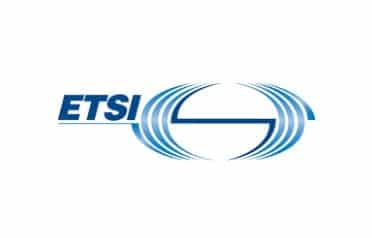


Testing, Conformance and Interoperability
Cooperate in the area of multi-access edge computing, share resources, and coordinate technical, testing and deployment activities.

Support to C-V2X Conformance Testing and Certification in respective regions of operation

Support to C-V2X Conformance Testing and Certification in respective regions of operation
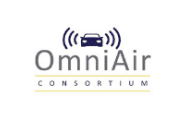
Collaboration in the process of testing C-V2X technology through various means, in support of identifying use and business cases for connected vehicles

Promotion Groups and Think Tanks
Cooperation to boost deployment of connected cars and safer roads by working across industries to focus on privacy/security, common standards and target the 5.9GHz spectrum band specifically for the internet of vehicles

Progression of the development of Cellular-V2X, commitment to the promotion of a global unified C-V2X standard and E2E industry, building of a deeply integrated and innovated C-V2X ecosystem among automotive, telecommunication and more vertical industry partners

Enhancement and fostering of a closer cooperation in the area of 5G-based V2X solutions

Regional Partners
Europe
Cooperation towards network deployment for mobility services.

Exchange of information, seeking solutions concerning the use of radio frequencies to facilitate the development of future mobility and transportation services especially for the purpose of ITS communications

Promotion and coordination as necessary of the Baltic Sea Region 5G Ecosystem Forum with the Electronic Communication Office of Latvia

Coordination of technical, testing and deployment activities in relation to connected and automated driving, standardization priorities supporting connected and automated driving, promotion on spectrum-related issues and agreement on usage modalities of certain bands





Korea
Partnership to exchange of information regarding 5G mobile communication technology related to Automotive and Road Transport, analysis of technology trends, discussion of global standardization trends, promotion of 5G and C-V2X ecosystem growth

Partnership to facilitate sharing information on 5G mobile technology in Automotive and Road Transport, analysis of technology trends, discussion of global standardization trends, promotion of 5G and C-V2X ecosystem growth

China
fostering of cooperation in the field of connected and autonomous driving solutions, further conducting technical research on LTE-V2X and 5G-V2X, ensuring the promotion of the applications of 5G based V2X solution

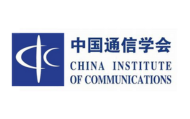
Japan
Cooperation between 5GAA and members of 5G MF with reference to the Japanese 5G ecosystem

United States



